Suriname is a small country in South America that is home to an incredible variety of bird species. From colorful parrots and toucans to majestic eagles and hawks, there is no shortage of beautiful and unique birds that can be seen in the forests and jungles of Suriname.
As one of the most biodiverse countries in the world, Suriname is a paradise for birdwatchers and nature enthusiasts alike. In this article, we will explore the fascinating birds of Suriname and the best places to spot them.
1. Wattled Jacana
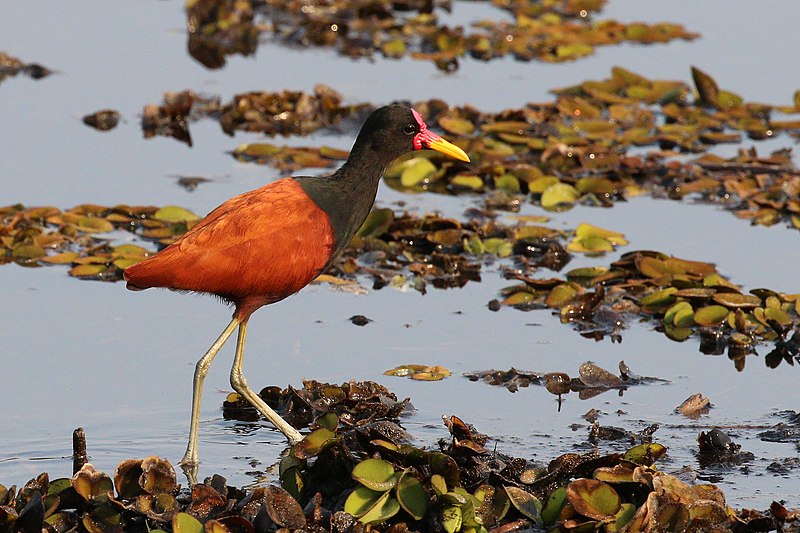
The Wattled Jacana is a stunning bird from central and south America. It has long legs, a black head with yellow wattles at each side, and striking chestnut brown wings.
This wader builds its nest on the surface of ponds or lakes using floating vegetation such as lily pads to anchor it in place – usually with four eggs that are darkly marked.
The male takes primary responsibility for incubation of these eggs between his wings, while the female will take care of her chicks once they hatch out.
These birds feed mainly on aquatic insects but also small fish and amphibians if available.
Overall this species is an interesting and attractive addition to any wetland habitat.Scientific classification:
| Kingdom | Animalia |
| Phylum | Chordata |
| Class | Aves |
| Order | Charadriiformes |
| Family | Jacanidae |
| Genus | Jacana |
| Species | J. jacana |
2. Passerine
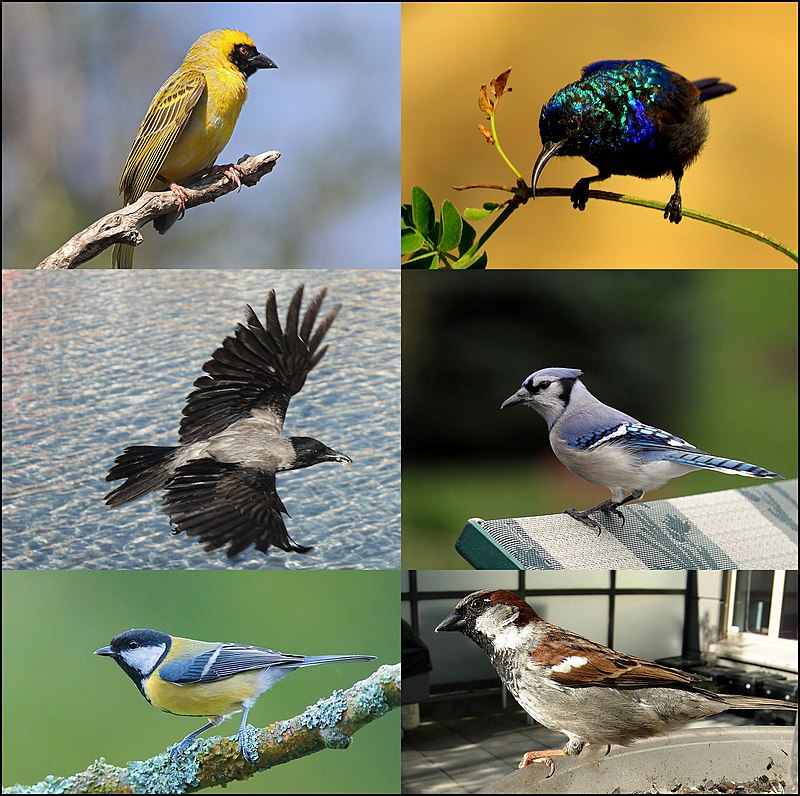
Passerines are a vast order of birds, comprising more than half the species in existence. Many familiar garden and woodland species fall into this category such as sparrows, blackbirds, finches and warblers.
They can be recognised by their arrangement of toes; three pointing forward with one back which helps them perch on branches or wires.
Passerines range from tiny wrens to large crows and have adapted to inhabit many environments around the world including forests, mountainsides and deserts.
They feed mainly on insects but some also consume fruit and seeds depending on their diet preferences.
Their diversity is truly remarkable from vibrant coloured tropical parrots to drab winter thrushes – making passerine birds an integral part of our natural heritage.Scientific classification:
| Kingdom | Animalia |
| Phylum | Chordata |
| Class | Aves |
| Clade | Psittacopasserae |
| Order | Passeriformes Linnaeus, 1758 |
3. Cotinga
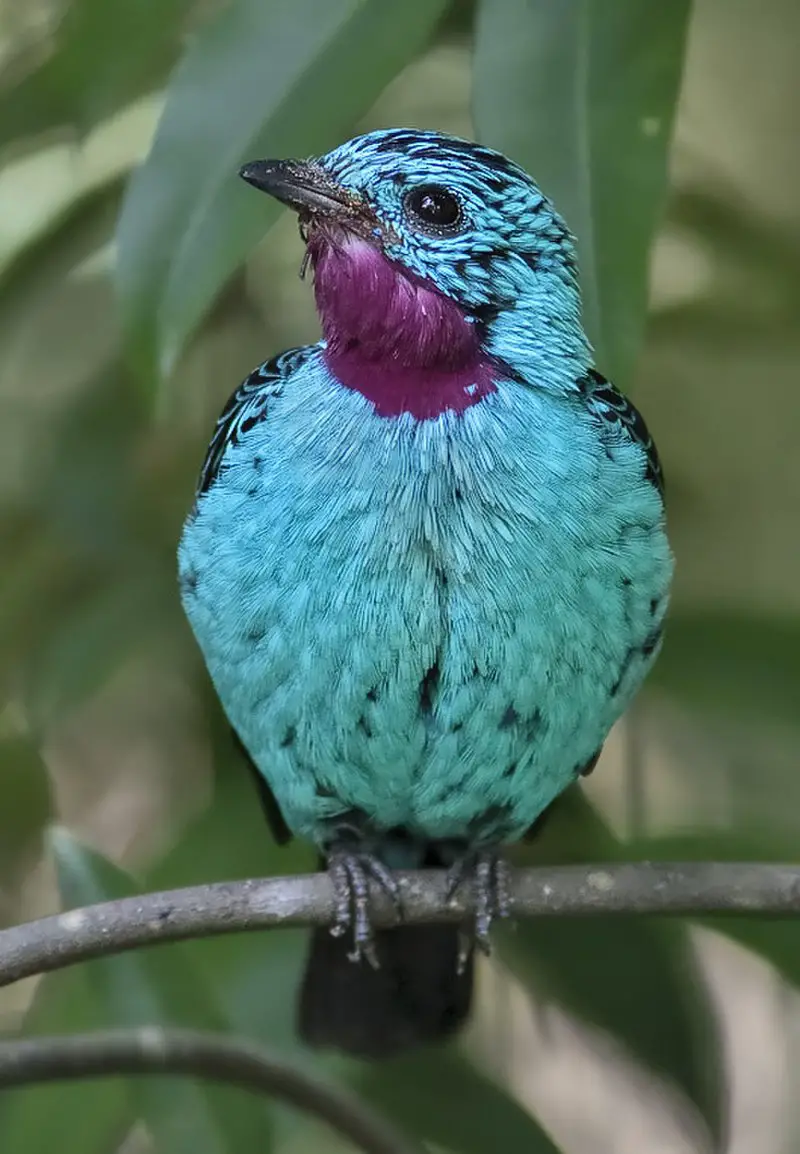
Cotingas are a large family of passerine birds that inhabit Central and South America. They have broad bills with hooked tips, rounded wings, and strong legs.
These colorful birds usually live in forests or forest edges and feed mainly on fruits. Cotinga species range from 12-13 cm (4.7–5.1 inches) to 48-51 cm long depending on the type of bird.
The fiery-throated fruiteater is among the smallest members while others like cocks -of –the rock can reach up to 51cm long.
All these birds display spectacular colors which makes them popular amongst bird watchers all over the world..Scientific classification:
| Kingdom | Animalia |
| Phylum | Chordata |
| Class | Aves |
| Order | Passeriformes |
| Parvorder | Tyrannida |
| Family | Cotingidae Bonaparte, 1849 |
4. Great Kiskadee
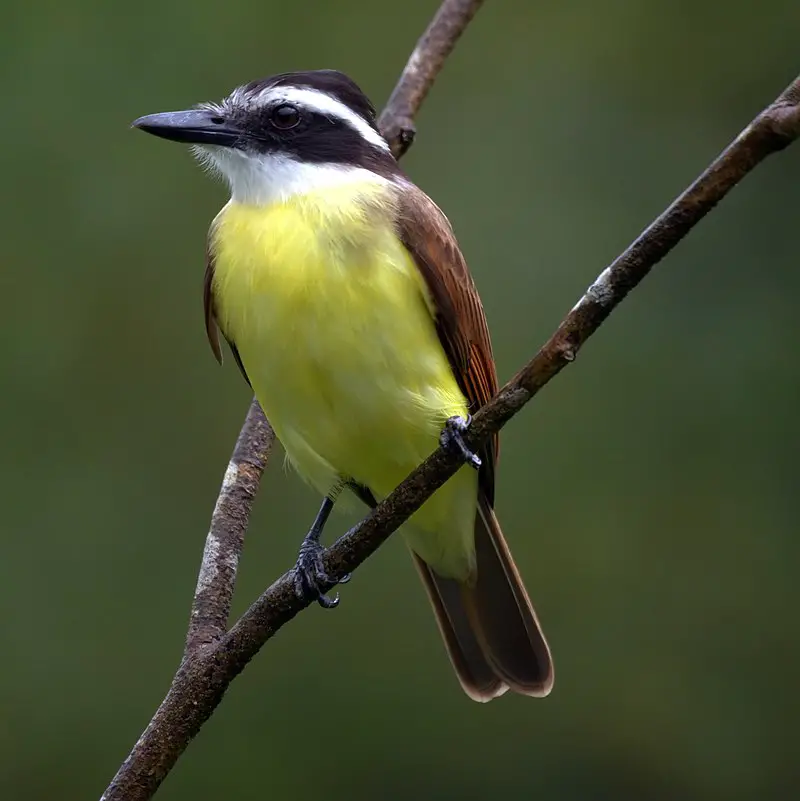
The Great Kiskadee is a passerine bird belonging to the Tyrant Flycatcher family.
It has an unmistakable yellow and black plumage, making it easily recognizable in its native habitats of Belize, Texas, Argentina and Brazil where it is known as Bem-te-vi or Benteveo respectively.
The species inhabits open woodland with some tall trees such as cultivation areas and other places surrounding human dwellings.
This adaptable bird feeds mainly on insects but also consumes fruit for energy when needed.
Its call resembles laughter which adds to its charm among avid nature watchers who are always delighted by their presence.
A unique feature that sets this species apart from others is that they can imitate songs of other birds accurately too.Scientific classification:
| Kingdom | Animalia |
| Phylum | Chordata |
| Class | Aves |
| Order | Passeriformes |
| Family | Tyrannidae |
| Genus | Pitangus Swainson, 1827 |
| Species | P. sulphuratus |
5. Puffbird
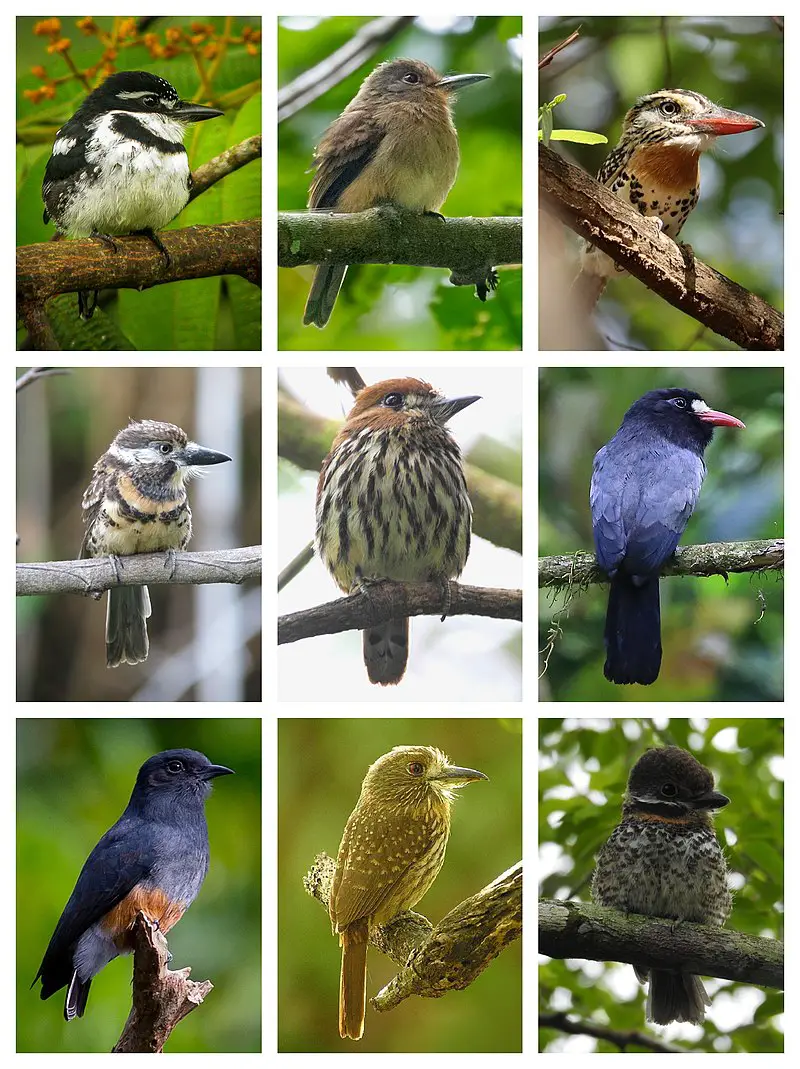
The Puffbird is a tropical tree-dwelling bird found in South America, Mexico and Central America.
It belongs to the near passerine family Bucconidae, which also includes jacamars – its closest relatives.
The order Piciformes unites these two families although some consider them separate under Galbuliformes.
Unlike other birds of the same group that have dazzling iridescent feathers, puffbirds are more modestly coloured with their greyish brown plumage blending into their environment for camouflage purposes when perched on trees or shrubs searching for insects as food sources using their long pointed bill.
They can be quite difficult to spot due to being small and well camouflaged but they may give away their presence by calling out loudly with an unmistakable whistling soundScientific classification:
| Kingdom | Animalia |
| Phylum | Chordata |
| Class | Aves |
| Order | Piciformes |
| Suborder | Galbuli |
| Family | Bucconidae Horsfield, 1821 |
6. Snowy Egret
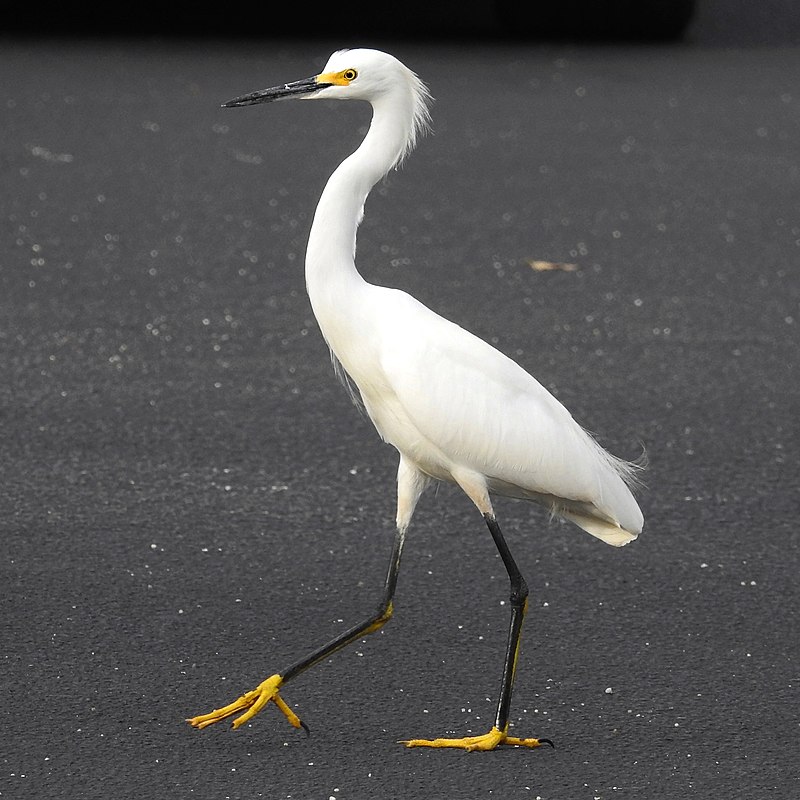
The Snowy Egret is a small white heron native to North America. Its scientific name, Egretta thula, comes from Provençal French for the little egret and an incorrect reference to the Black-necked Swan by Chilean naturalist Juan Ignacio Molina in 1782.
This beautiful bird has black legs with yellow feet, and a long plume of feathers on its head that often appears as if it’s wearing a crown.
It feeds primarily on insects and aquatic life like fish or frogs making it well adapted for both wetland habitats such as marshes or swamps plus coastal areas close to shorelines.
With their graceful movements they are truly delightful creatures to observe while out exploring nature.Scientific classification:
| Kingdom | Animalia |
| Phylum | Chordata |
| Class | Aves |
| Order | Pelecaniformes |
| Family | Ardeidae |
| Genus | Egretta |
| Species | E. thula |
7. Blue-Gray Tanager
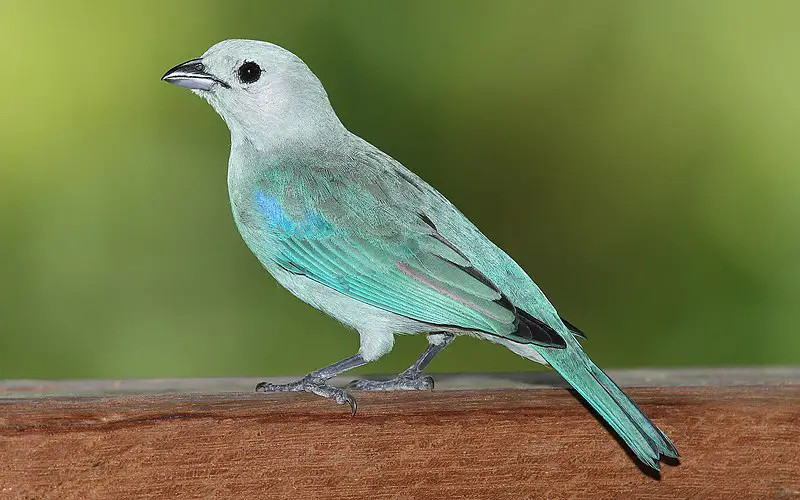
The blue-gray tanager is a medium-sized songbird native to South America, ranging from Mexico all the way down to northern Brazil and Bolivia.
It has been introduced in Lima, Peru as well as Trinidad and Tobago where it is called “blue jean”.
This species was first described by French zoologist Mathurin Jacques Brisson in 1760. The bird’s plumage features hues of gray, blue, yellow and green creating an attractive contrast against its white belly.
Its diet consists mainly of insects like beetles but also fruits such as figs are known to be part of their daily nutrition.
Blue-gray tanagers usually inhabit humid forests near running watercourses making them relatively easy to spot while they search for food on tree branches or foliage cover around streams during the day time.Scientific classification:
| Kingdom | Animalia |
| Phylum | Chordata |
| Class | Aves |
| Order | Passeriformes |
| Family | Thraupidae |
| Genus | Thraupis |
| Species | T. episcopus |
8. Ruddy Ground Dove
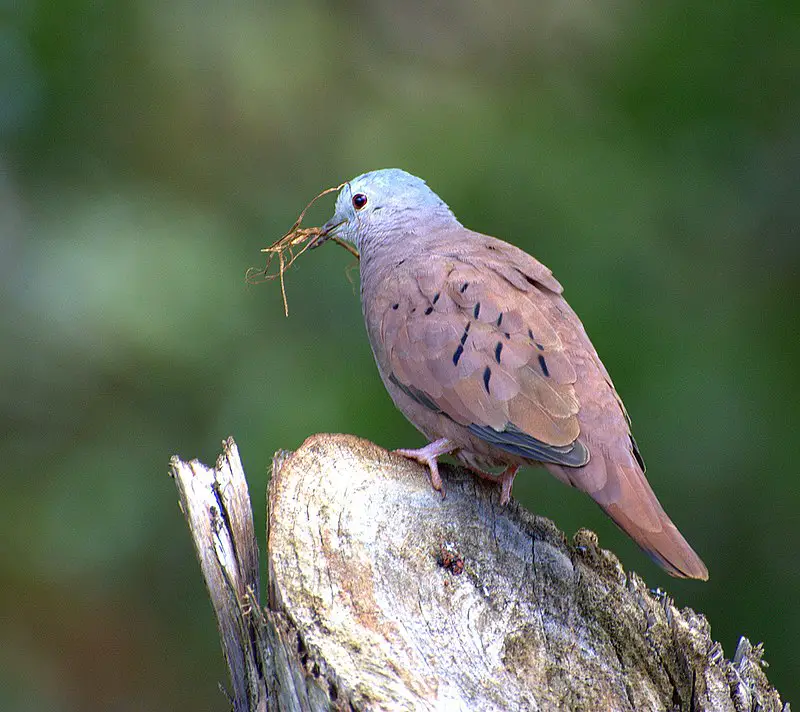
The Ruddy Ground Dove is a small New World tropical bird, found across Mexico and South America as far south as Argentina. It is also seen in the southwestern United States during winter months.
This ground dove typically lives in scrub or other open habitats such as savannas and grasslands, where it feeds on seeds from plants like cactus fruits.
Its plumage ranges from grey to reddish-brown with a light tan breast and black markings throughout its wings and tail feathers.
The male has more distinguishable colouration than the female but both sexes have bright red eyes which give this species its name – ‘ruddy’.
They are often observed perching low to the ground near food sources or nesting sites while also being quite vocal when flying between locations making them easier to spot.Scientific classification:
| Kingdom | Animalia |
| Phylum | Chordata |
| Class | Aves |
| Order | Columbiformes |
| Family | Columbidae |
| Genus | Columbina |
| Species | C. talpacoti |
9. Pale-Breasted Thrush
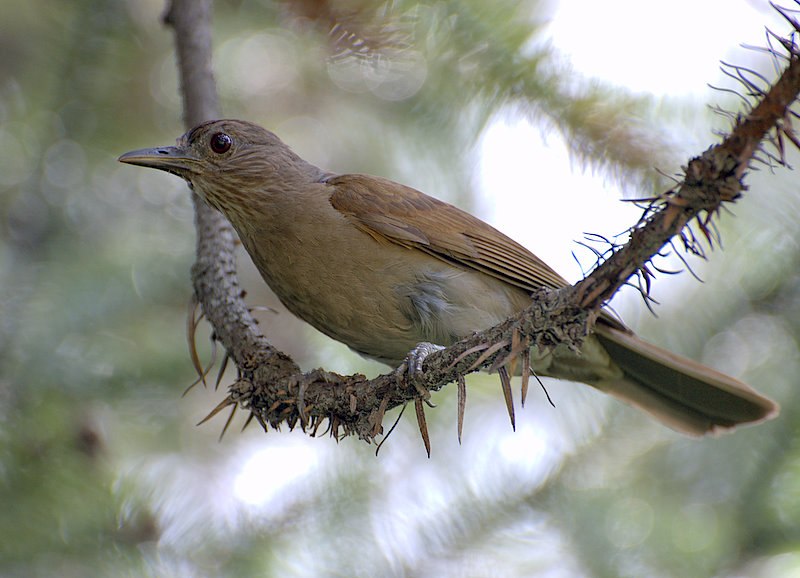
The Pale-breasted Thrush is a species of bird found in eastern and northern South America, from Brazil to Uruguay. It lives in wooded habitats such as gardens or shrubs.
This adaptable creature has no problem living near humans and can even be seen nesting close by. The thrush’s plumage varies between sexes – males having black heads, white breasts and grey wings with yellowish edging; females are more brown overall but still have the distinctive white breast patch.
They eat both fruit and insects which they search for on the ground among leaf litter or under vegetation.
These birds form monogamous pairs during breeding season which usually starts around September/October time when their song is often heard coming from treetops.Scientific classification:
| Kingdom | Animalia |
| Phylum | Chordata |
| Class | Aves |
| Order | Passeriformes |
| Family | Turdidae |
| Genus | Turdus |
| Species | T. leucomelas |
10. Tropical Mockingbird
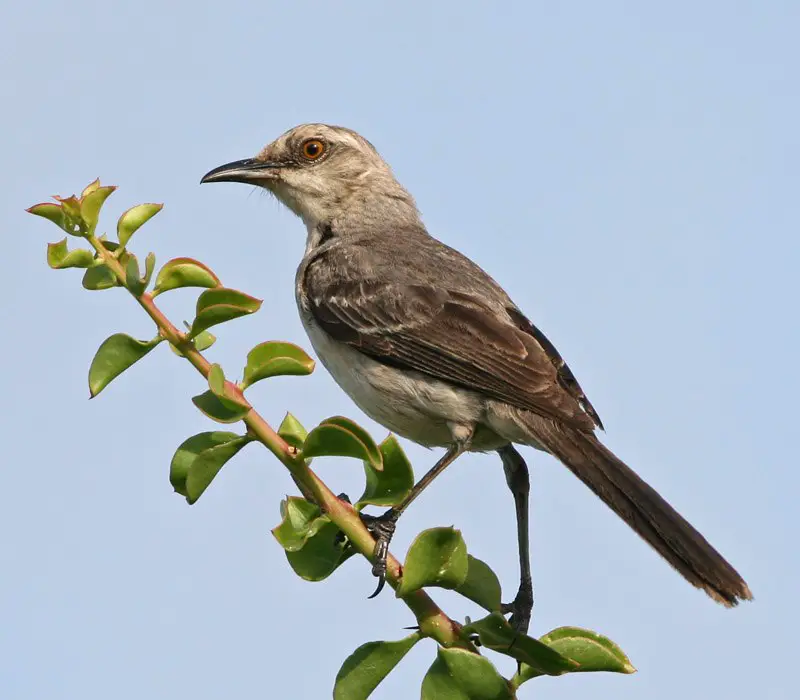
The Tropical mockingbird is a species of bird found throughout Central America and the Caribbean. It has been classified as a resident breeding bird, with its range stretching from southern Mexico to northern and eastern South America.
This species is closely related to the Northern Mockingbird, forming what is known as a superspecies between them both.
The Tropical mockingbird can be recognized by its grey-brown coloration on top, blending into white underparts which are highlighted by black spots along their throat and wings.
They have long legs for perching in trees or shrubs while searching for prey such as insects before singing out melodic songs during territorial disputes with other birds in the area.
Sadly, one subspecies -the San Cristobal Mockingbird – has been listed as critically endangered due to habitat destruction caused by human activities including logging within their natural environment.Scientific classification:
| Kingdom | Animalia |
| Phylum | Chordata |
| Class | Aves |
| Order | Passeriformes |
| Family | Mimidae |
| Genus | Mimus |
| Species | M. gilvus |
11. Tropical Kingbird
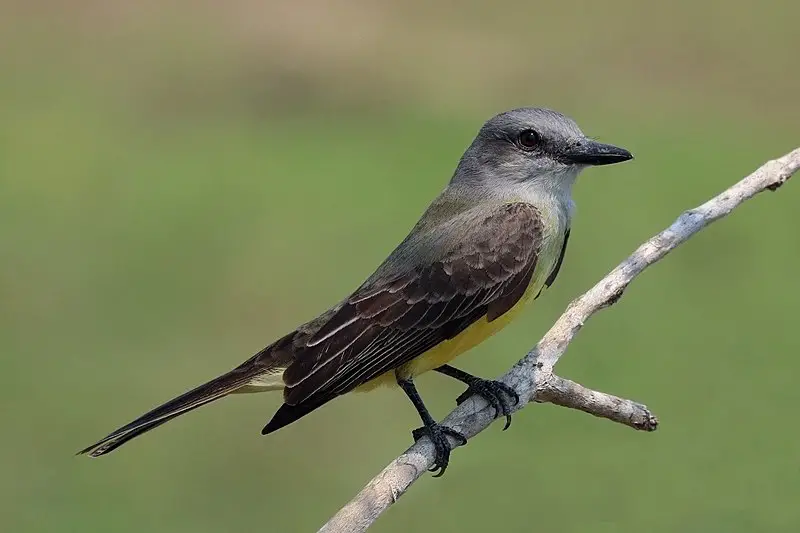
The Tropical Kingbird is an impressive bird, native to the Americas. It’s a large tyrant flycatcher that breeds in southern Arizona and Texas through Central America and down south as far as Argentina and Peru.
This species also lives on Trinidad & Tobago islands. During cold winter months, most of them migrate to warmer climates within its range.
They inhabit open areas such as fields or forests with scattered trees – but away from heavily wooded habitats.
In terms of diet, they mainly feed upon insects which are caught by hawking from perches or snatching up in flight; however it will occasionally eat fruits too.
The adult has grey-brown upperparts, darker wings edged with yellowish feathers plus a white breast band contrasting against pale orange underparts for both sexes.
A conspicuous black mask runs across their eyes completing this beautiful bird’s look.Scientific classification:
| Kingdom | Animalia |
| Phylum | Chordata |
| Class | Aves |
| Order | Passeriformes |
| Family | Tyrannidae |
| Genus | Tyrannus |
| Species | T. melancholicus |
12. Grey-Winged Trumpeter
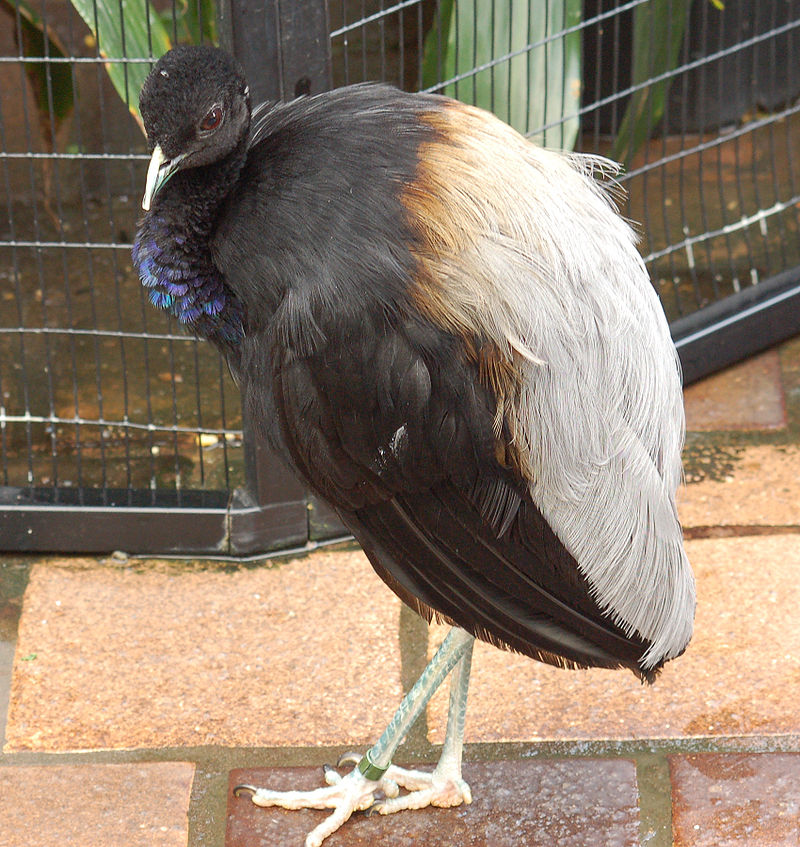
The Grey-winged Trumpeter is a species of bird found in South America, spanning Brazil, Colombia, Ecuador and several other countries.
It belongs to the small family Psophiidae and has an uncertain taxonomy; this is being studied by various organisations such as the International Ornithological Committee (IOC).
They are usually around 35 cm long with grey wings and brown eyes. This species typically lives in humid lowland forests or adjacent woodlands.
Its diet consists mainly of fruits, seeds and some invertebrates which it finds on the ground or near trees.
The mating season for these birds occurs from October to February when they build nests made out of twigs lined with leaves close to their food sources for protection against potential predators.
Although not currently threatened due to its wide range distribution across multiple countries there may be localised threats that need monitoring in order for them survive into future generations.Scientific classification:
| Kingdom | Animalia |
| Phylum | Chordata |
| Class | Aves |
| Order | Gruiformes |
| Family | Psophiidae |
| Genus | Psophia |
| Species | P. crepitans |
13. Harpy Eagle
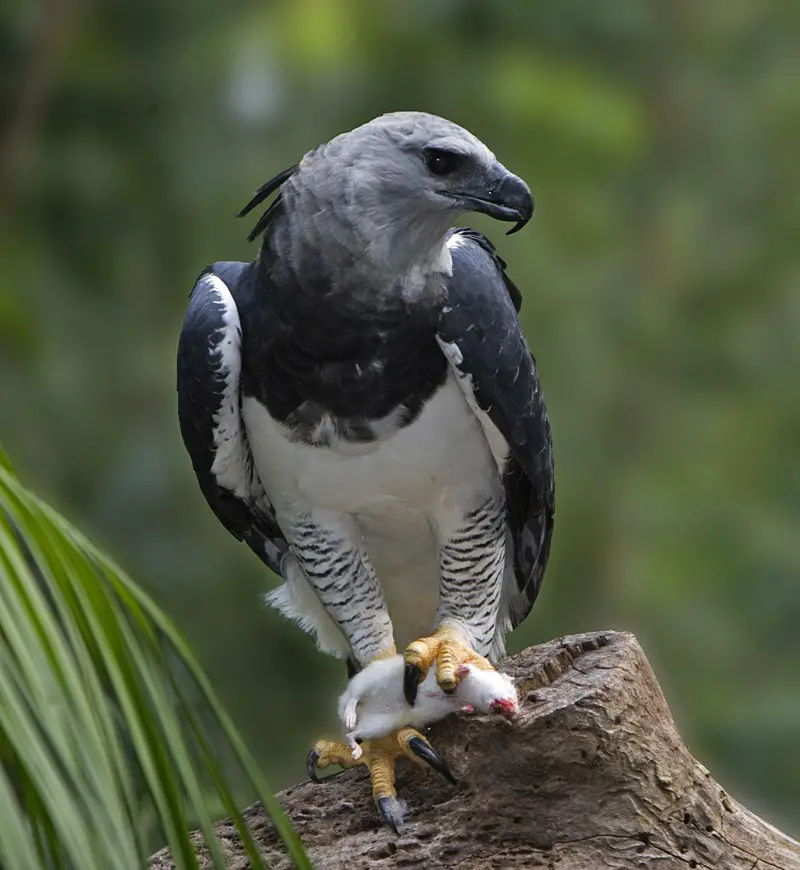
The Harpy Eagle is a magnificent bird of prey found in the tropical forests of Central and South America. It is the largest eagle on Earth, possessing an impressive wingspan that can reach up to 7 feet across.
Its powerful talons are its most distinguishing feature, being able to grasp even large animals such as monkeys or sloths with ease.
The majestic raptor has slate-gray feathers on its back and head which contrast against white undersides and yellow legs.
These birds live alone for much of their life but will come together during breeding season when they construct elaborate nests high off the ground in tall trees.
People have long been fascinated by this species’ impressive size and strength—it truly deserves its nickname as “the lord of skies”.Scientific classification:
| Kingdom | Animalia |
| Phylum | Chordata |
| Class | Aves |
| Order | Accipitriformes |
| Family | Accipitridae |
| Subfamily | Harpiinae |
| Genus | Harpia Vieillot, 1816 |
| Species | H. harpyja |
14. Toucans
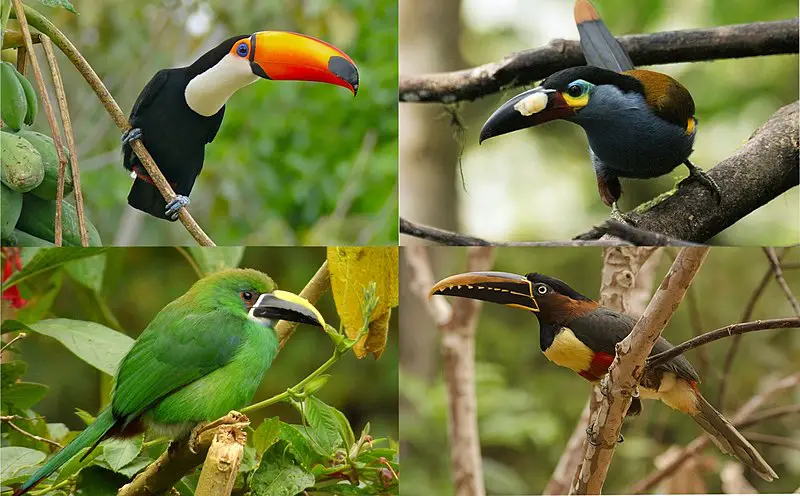
Toucans are members of the Ramphastidae family, which is closely related to American barbets. These birds have brightly-colored feathers and large beaks that come in a variety of colors.
They tend to live high up in trees, where they make their nests with two or four white eggs inside.
Toucans typically feed on fruits and sometimes small insects as well. Some species can even catch larger animals such as reptiles and amphibians for food.
Although toucans like to keep close together when living in groups, during breeding season they become more aggressive towards each other due to competition over resources like nesting sites or food sources.Scientific classification:
| Kingdom | Animalia |
| Phylum | Chordata |
| Class | Aves |
| Order | Piciformes |
| Infraorder | Ramphastides |
| Family | Ramphastidae Vigors, 1825 |
15. Orange-Winged Amazon
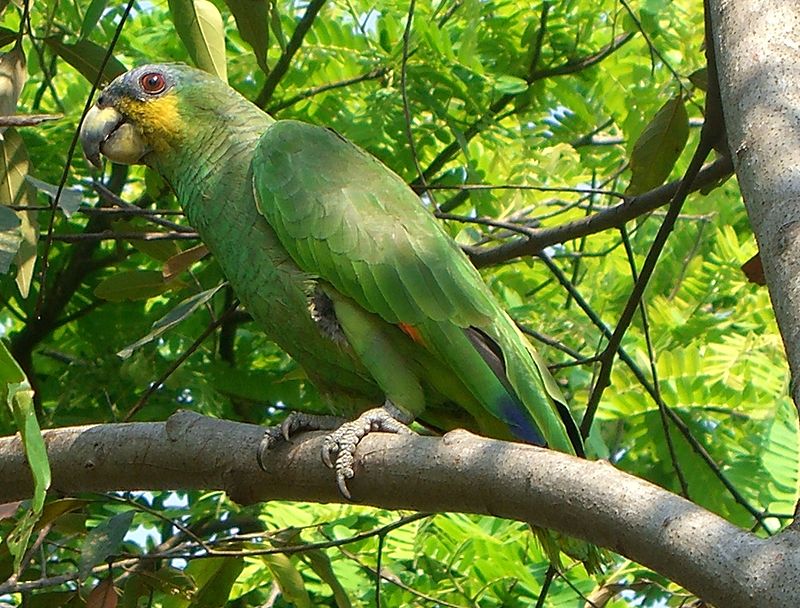
The orange-winged amazon is a vibrant and large parrot native to South America. Its habitat consists of both tropical forests and semi-open country areas, spanning from Colombia, Trinidad & Tobago down to Peru, Bolivia and central Brazil.
Although its population seems healthy at the moment due to its wide range throughout these countries, it still suffers persecution as an agricultural pest as well as capture for the pet trade industry.
It has striking features that make it easily distinguishable; namely bright red feathers on its forehead along with yellowish-orange wings which give this bird its name.
With proper protection against poaching and hunting by humans in place they should remain a colorful addition to our planet’s avian family.Scientific classification:
| Kingdom | Animalia |
| Phylum | Chordata |
| Class | Aves |
| Order | Psittaciformes |
| Family | Psittacidae |
| Genus | Amazona |
| Species | A. amazonica |
16. Chestnut-Belted Gnateater
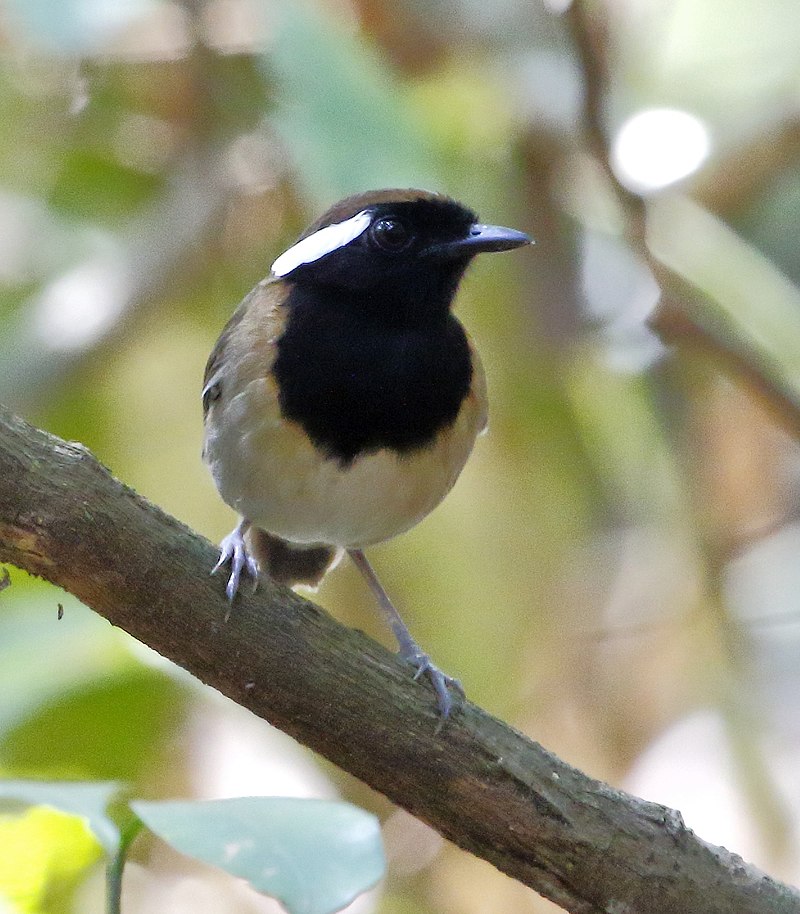
The Chestnut-belted Gnateater is a small bird found in the Amazon Basin, as well as parts of Colombia and Peru. It has an unmistakable chestnut belt that wraps around its neck and back area.
This species belongs to the Conopophagidae family of birds, also known as gnatcatchers or flyeaters.
They feed on insects such as flies and ants which they glean from foliage while moving through trees with their long bill pointed downwards searching for food items.
The adult adults have an almost entirely black plumage with a white stripe across the forehead; juveniles are more brownish overall but still feature a distinct chestnut belt like their parents do when fully grown up.
They inhabit tropical moist lowland forests where they move near understory vegetation looking for prey and build nests among branches or tangles of vines to raise young during breeding season months between March – September each year depending upon regionality..Scientific classification:
| Kingdom | Animalia |
| Phylum | Chordata |
| Class | Aves |
| Order | Passeriformes |
| Family | Conopophagidae |
| Genus | Conopophaga |
| Species | C. aurita |
17. Black-Crested Antshrike
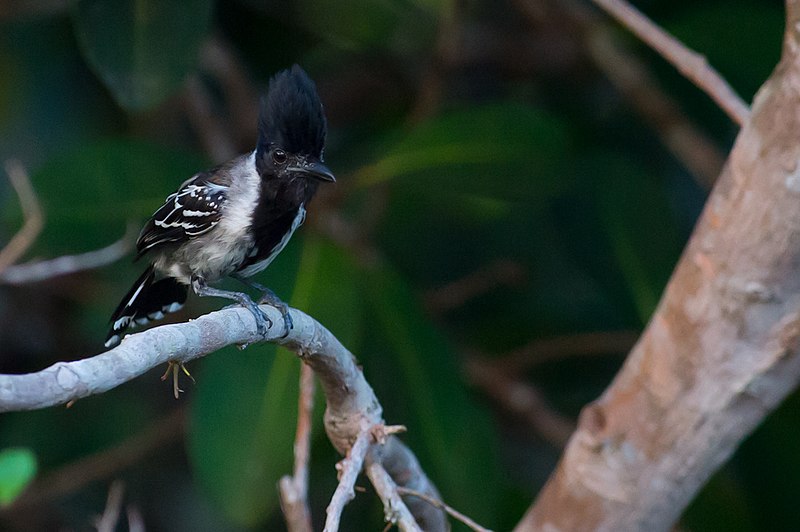
The Black-crested Antshrike is a beautiful bird native to tropical South America, found in countries such as Trinidad, Colombia, Venezuela and Brazil. It has black plumage with white stripes on its wings and back.
Its most distinguishing feature is the bright yellow crest atop its head which it raises during courtship displays or when alarmed.
This species prefers humid forests where they feed mainly on insects by searching through foliage for prey items using their long bills.
They are usually seen singly or in pairs perched high up among branches while looking out for food below them in the undergrowth.
The Black-crested Antshrike can be identified easily due to their loud call which sounds like ‘churr churr’ – quite distinctive compared to other birds of similar size.
These charismatic creatures play an important role within their ecosystems helping maintain healthy insect populations that support many other life forms around them too.Scientific classification:
| Kingdom | Animalia |
| Phylum | Chordata |
| Class | Aves |
| Order | Passeriformes |
| Family | Thamnophilidae |
| Genus | Sakesphorus |
| Species | S. canadensis |
18. Ringed Kingfisher
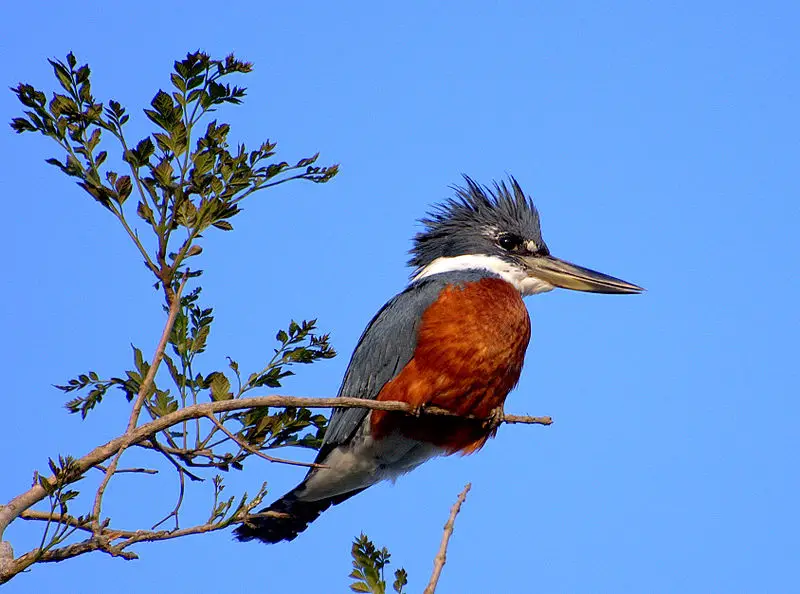
The Ringed Kingfisher is a large, vibrant bird that can be easily noticed by its loud call. It’s found in tropical regions from the lower Rio Grande Valley of southeastern Texas to Central America and even as far south as Tierra del Fuego.
This ground-dwelling species prefers to inhabit open areas near water bodies like streams, rivers and lakes which provide them with plenty of food such as fish, amphibians, crustaceans and insects.
In 1888 it was first identified by ornithologist Frank Chapman who noted its distinct ring pattern on the breast area.
The upperparts are dark blue while underneath they have white spots around their neck and belly region along with pale brown wings tipped in black stripes making this species quite unique among other kingfishers.
They may look intimidating but these birds actually play an important role for humans since they help control insect populations thus helping maintain a healthy balance within our ecosystems.Scientific classification:
| Kingdom | Animalia |
| Phylum | Chordata |
| Class | Aves |
| Order | Coraciiformes |
| Family | Alcedinidae |
| Subfamily | Cerylinae |
| Genus | Megaceryle |
| Species | M. torquata |
19. Golden-Winged Parakeet
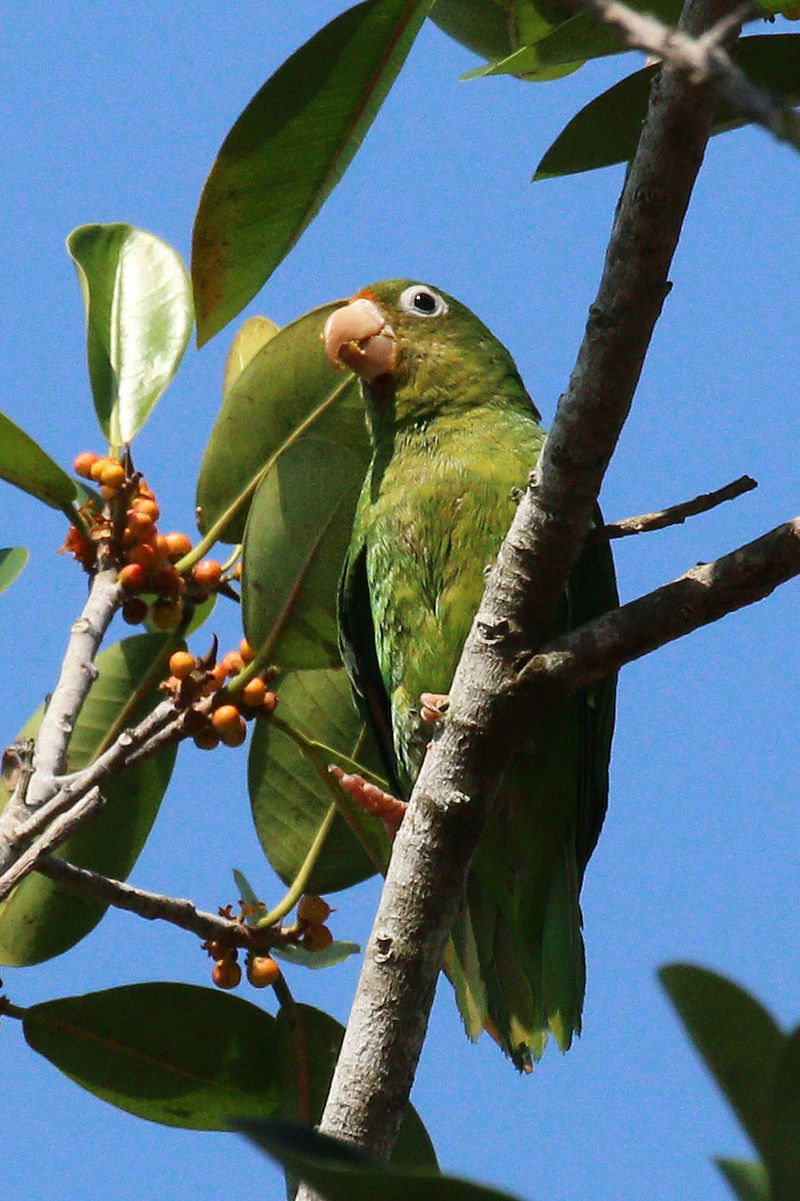
The Golden-winged Parakeet is a species of bird found in the Psittacidae family, commonly known as true parrots.
It was formally described by Carl Linnaeus in 1766 and given the binomial name of Psittacus chrysoptetus.
This small bird has an overall green plumage with yellow wings and tail feathers. Its head is greyish white while its bill is horn coloured, creating a contrasting look to its bright body colouring.
The Golden-winged Parakeet prefers open woodlands or savannas for habitat but can also be seen flying over fields searching for food such as fruits, seeds and flowers from shrubs and trees.
They form monogamous pairs during breeding season which usually occurs between September to January depending on geographical location.
However their population numbers are decreasing due to deforestation leading them to become endangered in some parts of South America where they originate from.Scientific classification:
| Kingdom | Animalia |
| Phylum | Chordata |
| Class | Aves |
| Order | Psittaciformes |
| Family | Psittacidae |
| Genus | Brotogeris |
| Species | B. chrysoptera |
20. Channel-Billed Toucan
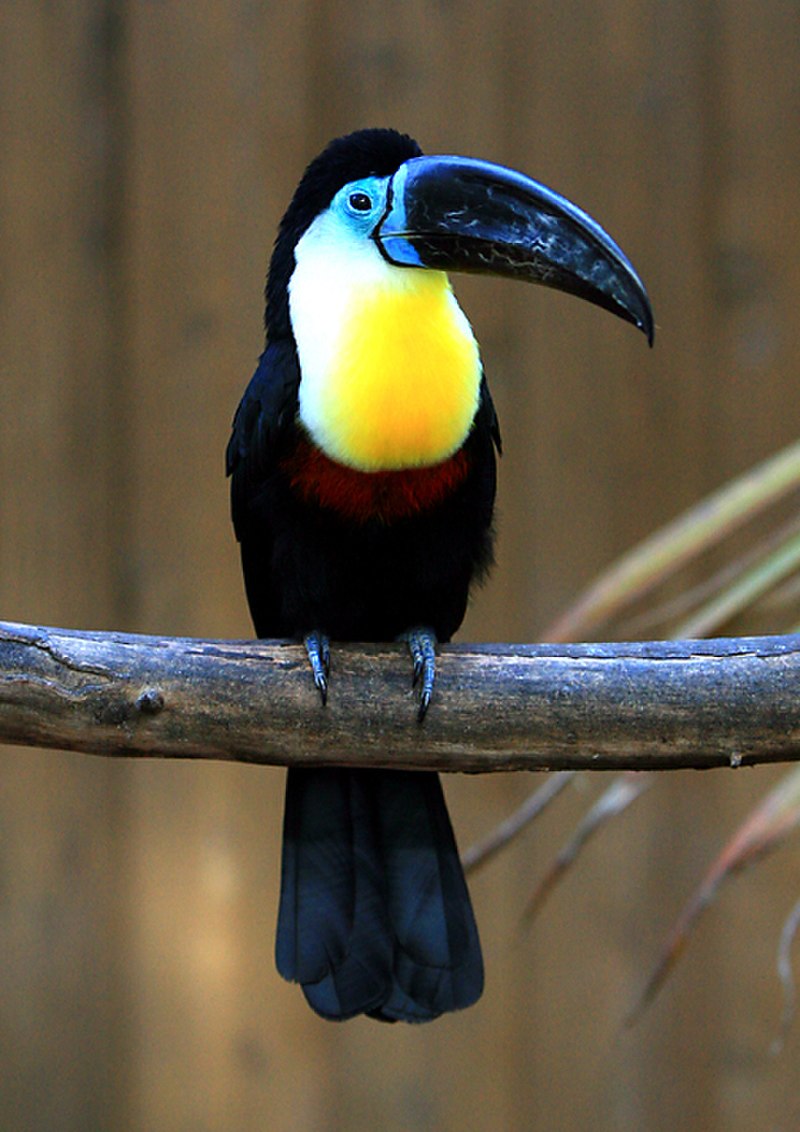
The Channel-billed Toucan is a large and beautiful bird of tropical South America, ranging from Trinidad to Bolivia. It belongs to the Ramphastidae family and has three recognized subspecies.
This toucan stands out with its strong beak that is brightly coloured in yellow, black, red and white hues; it’s usually used for reaching fruits high up on trees.
They also feature colourful eyes which can vary depending on their habitat – they may have brown or orange irises.
The Channel-billed Toucans are mainly frugivorous (fruit eaters) but will occasionally hunt small animals like lizards as well.
These birds live in groups of around 8 individuals and make loud calls during mating season or when defending their territory against other species such as parrots or hawks.
With its unique beauty and ability to interbreed free with other toucan species, the Channel-Billed Toucan remains one of nature’s fascinating creatures.Scientific classification:
| Kingdom | Animalia |
| Phylum | Chordata |
| Class | Aves |
| Order | Piciformes |
| Family | Ramphastidae |
| Genus | Ramphastos |
| Species | R. vitellinus |
21. Grey-Fronted Dove
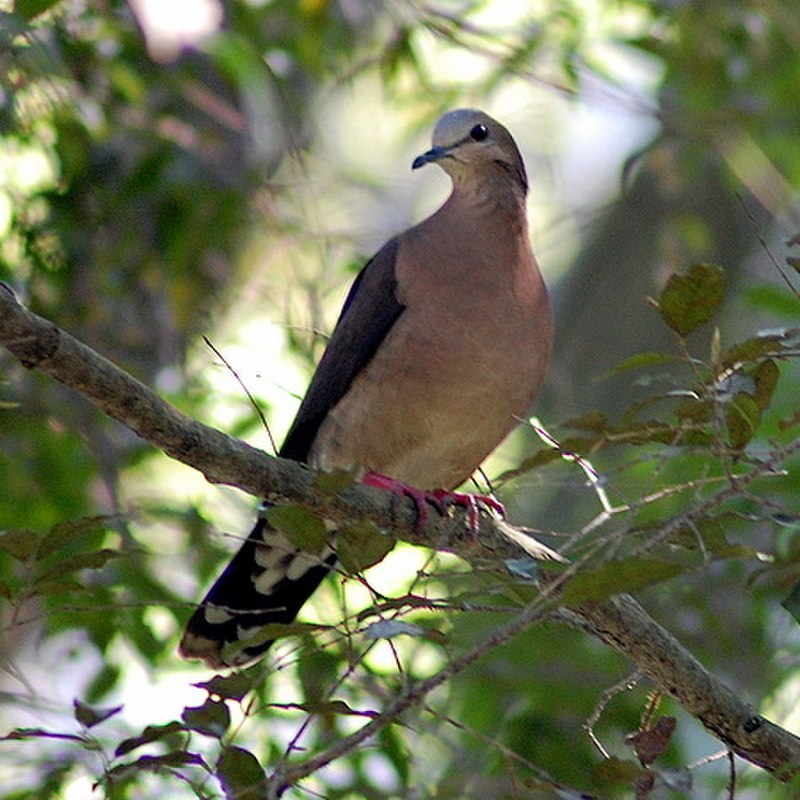
The Grey-fronted Dove is a beautiful bird that can be found in tropical regions across mainland South America, except Chile. It has grey plumage on its head and wings with a hint of pink near the tips.
Its body is light brownish color with white spots around the neck area. The tail feathers are black tipped with white at the ends which makes them look like they’re covered in snowflakes when viewed from behind.
They feed mainly on seeds but will also occasionally eat insects and fruit as well as drink nectar from flowers.
Their call sounds like “whoop-whoop” or “hoo-hoo-hooh” depending on where you live, giving it quite an interesting song for everyone to enjoy.
Not only do these birds have unique calls, but their beauty and grace make them stand out amongst other species of dove making them truly one of a kind.Scientific classification:
| Kingdom | Animalia |
| Phylum | Chordata |
| Class | Aves |
| Order | Columbiformes |
| Family | Columbidae |
| Genus | Leptotila |
| Species | L. rufaxilla |
22. Yellow-Bellied Elaenia
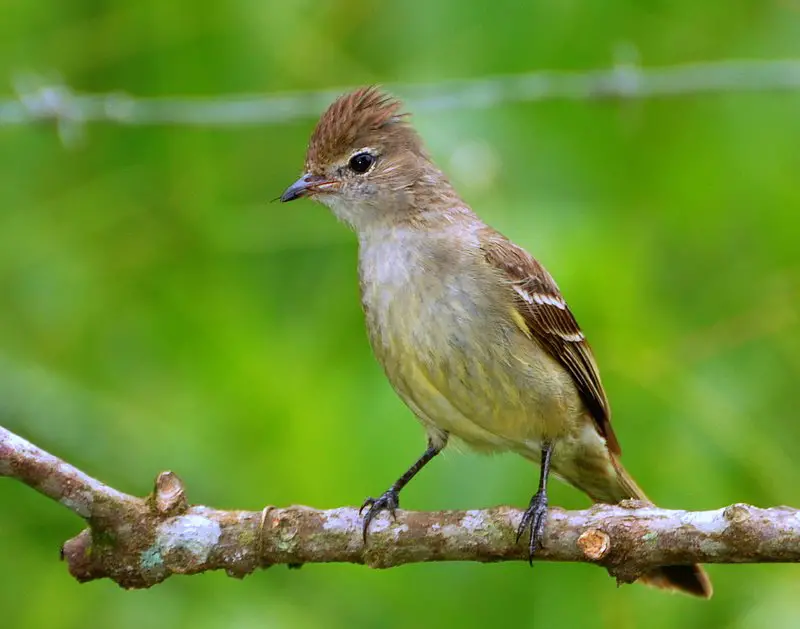
The Yellow-bellied Elaenia is a small bird in the tyrant flycatcher family. It is native to Mexico, Central and South America as well as Trinidad and Tobago.
These birds measure 16.5 cm (6.5 inches) long with an average weight of 24 g (0.85 oz). Their upperparts are olive-brown while their undersides are yellowish which gives them their name ‘Yellow-bellied’.
They have white eye rings, bushy divided crests, and white crown patches on top of their heads that helps identify them easily from other species like it.
The Yellow-bellied Elaenia prefer living near open wooded areas such as forest edges or second growth forests where they feed upon insects by catching them midair or off vegetation surfaces using its beak.Scientific classification:
| Kingdom | Animalia |
| Phylum | Chordata |
| Class | Aves |
| Order | Passeriformes |
| Family | Tyrannidae |
| Genus | Elaenia |
| Species | E. flavogaster |
Also Featured In: Savanna Birds You Need to See,
23. Palm Tanager
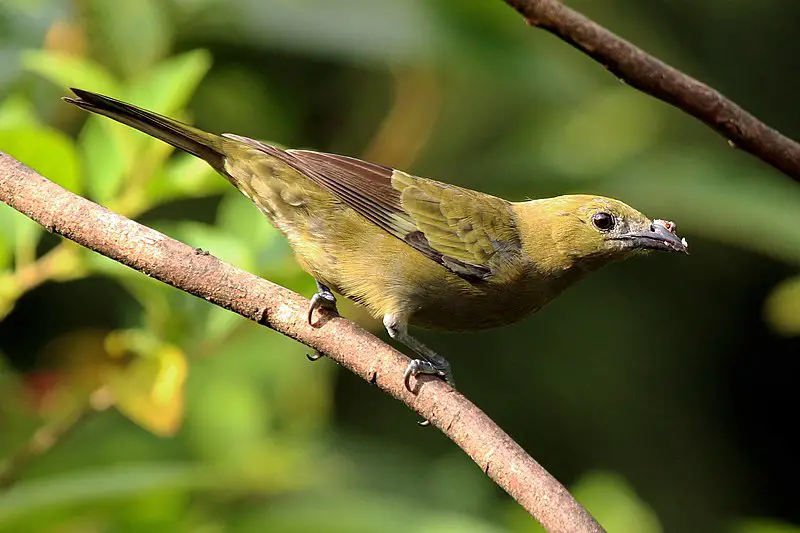
The Palm Tanager is a medium-sized passerine bird that breeds across Central and South America, from Nicaragua to Bolivia. It can also be found on the islands of Trinidad and Tobago since 1962.
This colorful tanager has a yellow head, green back and wings, grey chest and belly with black streaks, red rump feathers as well as blue flight feathers.
Its diet consists mainly of insects but it will feed on fruits too when they are available in its habitat which includes forests edges, woodland clearings an shrubland areas near water sources.
The Palm Tanagers have one brood per year consisting of 3 – 5 eggs laid directly onto the ground or low branches without any nest material being used for nesting purposes.Scientific classification:
| Kingdom | Animalia |
| Phylum | Chordata |
| Class | Aves |
| Order | Passeriformes |
| Family | Thraupidae |
| Genus | Thraupis |
| Species | T. palmarum |
Also Featured In: Birds that Live in Guyana,
24. Silver-Beaked Tanager

The Silver-beaked Tanager is a medium sized passerine bird native to South America. It has an unmistakable deep crimson head and velvety black body, making it a colorful addition to any environment.
Its 18 cm length and 25g weight are typical of its family; they are usually found in pairs or small flocks near open areas with trees for perching.
The tanager’s diet consists mainly of fruit and insects, which can be caught by hawking from the air or gleaned from foliage on the ground.
This species breeds throughout most of tropical South America east of the Andes Mountains, including Venezuela, Colombia, Peru and Brazil all the way down to Paraguay as well as Trinidad island off northern coast.
With their bright colors and easy presence around human habitation these birds make excellent subjects for amateur photographers.Scientific classification:
| Kingdom | Animalia |
| Phylum | Chordata |
| Class | Aves |
| Order | Passeriformes |
| Family | Thraupidae |
| Genus | Ramphocelus |
| Species | R. carbo |
Also Featured In: Silver Birds You Should Know,
25. White-Throated Toucan
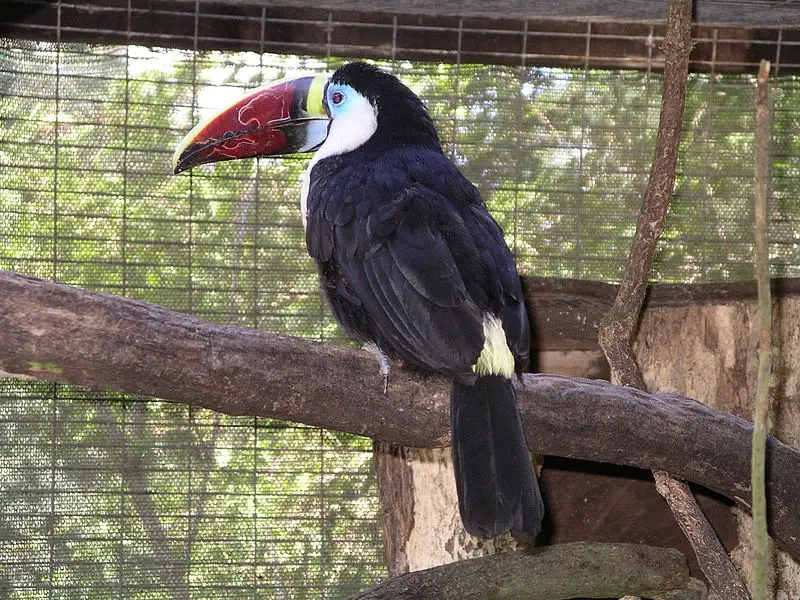
The White-throated toucan is an exotic bird found in the Amazon Basin, with its range extending to parts of Tocantins and Araguaia River.
It inhabits tropical humid forests as well as woodlands and cerrado areas near rivers.
This colorful bird was formally described by Swedish naturalist Carl von Linne in 1758, who gave it the scientific name ‘Ramphastos tucanus’.
The most distinctive feature of this species is its huge bill which measures from 14 cm to 20 cm long.
Its plumage consists mainly of black feathers with white throat patches on either side; red undertail coverts are also present.
In addition, they have a loud call consisting of three notes: “kow”, “tak” or “keh”. These amazing birds feed mostly on fruits but occasionally consume insects too.
All these features make them stand out amongst other birds.Scientific classification:
| Kingdom | Animalia |
| Phylum | Chordata |
| Class | Aves |
| Order | Piciformes |
| Family | Ramphastidae |
| Genus | Ramphastos |
| Species | R. tucanus |
26. Roadside Hawk
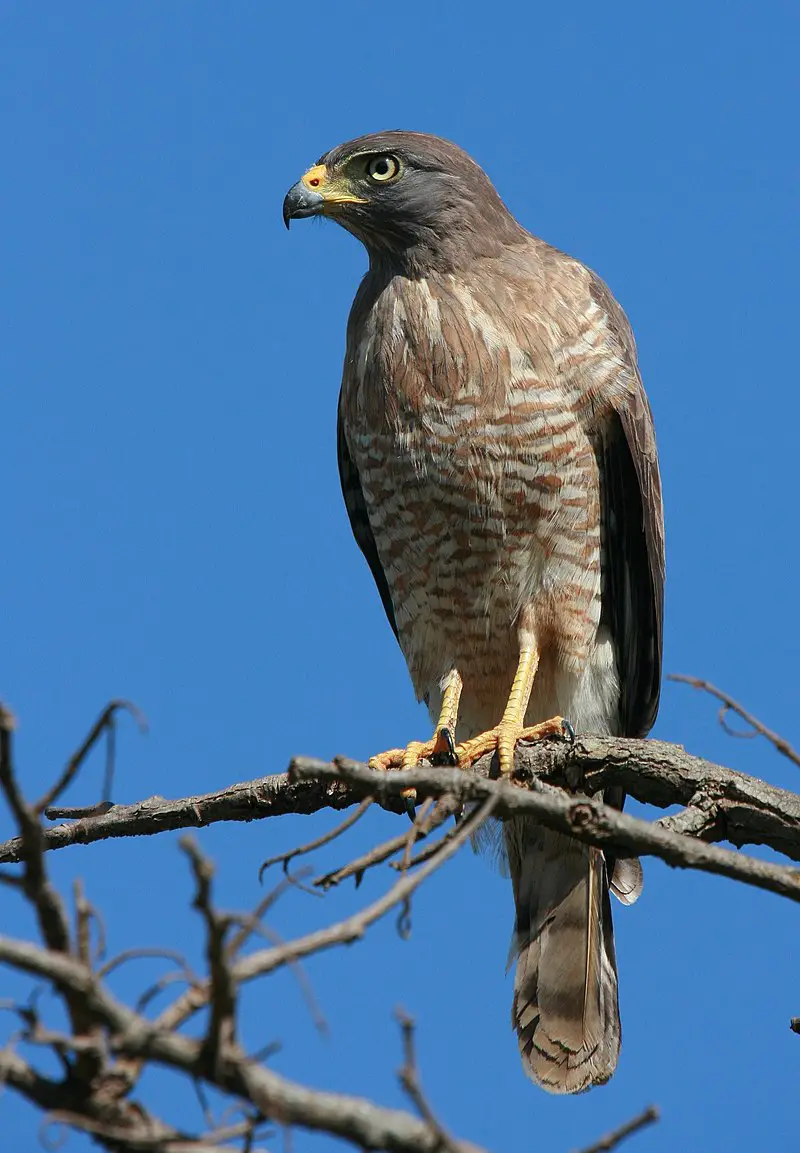
The Roadside Hawk is a small bird of prey found in the Americas. It has many subspecies, and its vocal nature makes it one of the most common raptors in its range.
Its scientific name is Rupornis magnirostris, which was formally described by German naturalist Johann Friedrich Gmelin back in 1788.
This hawk typically feeds on insects like grasshoppers and beetles as well as some smaller birds or mammals if available.
They also feed on carrion (dead animals) when other food sources are lacking or unavailable.
The roadside hawks’ nests can be seen near roadsides, agricultural fields and pastures where they hunt for their prey during the day time but roost at night to avoid predation from larger predators such as owls.
These bold hunters have adapted very well to human disturbance and make an important part of local ecosystems with their hunting capabilitiesScientific classification:
| Kingdom | Animalia |
| Phylum | Chordata |
| Class | Aves |
| Order | Accipitriformes |
| Family | Accipitridae |
| Genus | Rupornis Kaup, 1844 |
| Species | R. magnirostris |
Also Featured In: Common Carnivore Birds,
27. Bananaquit
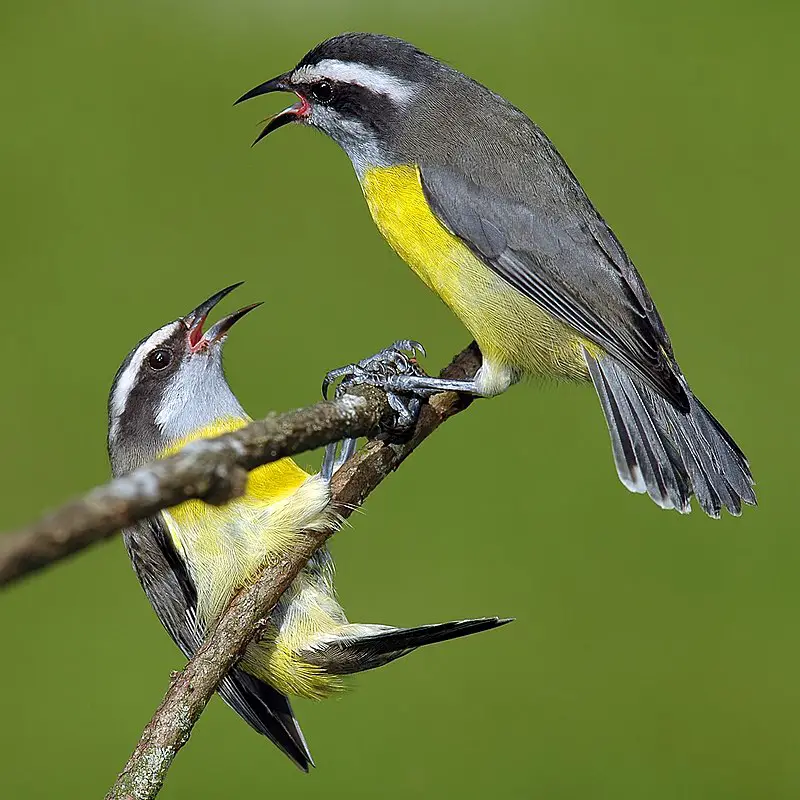
The Bananaquit, scientifically known as Coereba flaveola, is a small passerine bird belonging to the tanager family Thraupidae.
It was previously classified in either its own monotypic family or with other species such as buntings and New World sparrows (Emberizidae) or warblers (Parulidae).
This beautiful little bird has a yellow-green upper body, pale grey head and chestnut brown wings.
Its tail feathers are blackish while its belly is white with some faint streaks of olive green coloration.
The bananaquit can be found across Central America and the Caribbean islands where it feeds on fruits like bananas for which it gets its name from.Scientific classification:
| Kingdom | Animalia |
| Phylum | Chordata |
| Class | Aves |
| Order | Passeriformes |
| Family | Thraupidae |
| Genus | Coereba Vieillot, 1809 |
| Species | C. flaveola |
28. Smooth-Billed Ani
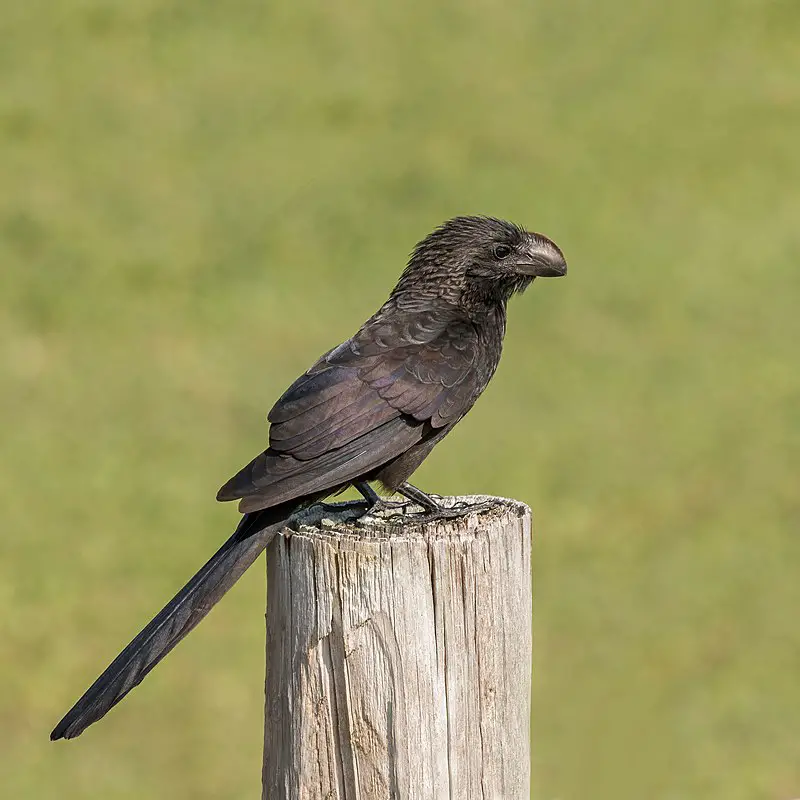
The Smooth-billed Ani is a species of bird in the cuckoo family, native to regions spanning from southern Florida and the Caribbean down through Central America, South America, and parts of Argentina.
They have even been introduced to Galapagos around 1960s where they may be impacting local wildlife due to their aggressive nature.
As its name suggests, these birds have smooth bills which are adapted for feeding on hard fruits or other items such as insects and lizards that it finds while scavenging around trees or ground level vegetation.
They usually form small flocks when out searching for food with males being slightly larger than females.
Overall this adaptable species is found in many habitats across its broad range but does best at low elevation open areas near water sources like marshes or swamps making them easier targets for human disturbance as well.Scientific classification:
| Kingdom | Animalia |
| Phylum | Chordata |
| Class | Aves |
| Order | Cuculiformes |
| Family | Cuculidae |
| Genus | Crotophaga |
| Species | C. ani |
29. Pied Water Tyrant
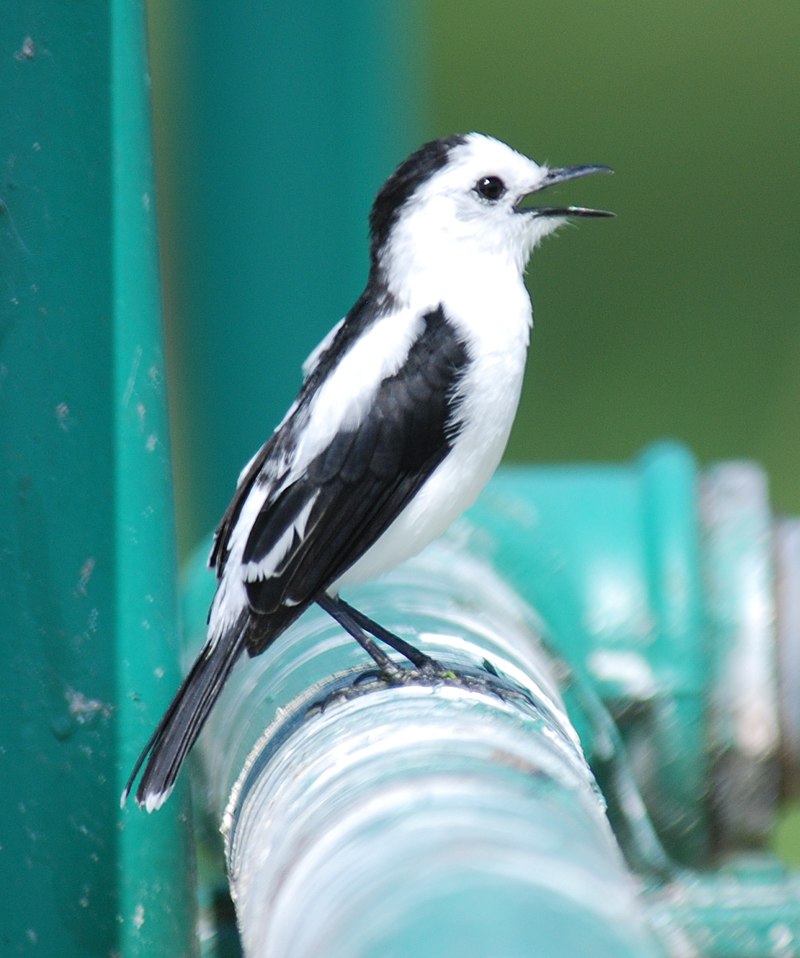
The Pied water tyrant is a small passerine bird in the tyrant flycatcher family, native to tropical South America. It has been described by French polymath Georges-Louis Leclerc, Comte de Buffon in 1779 from a specimen collected in Cayenne.
This species of bird is mostly black and white with some grey areas on its back and wings; it also displays beautiful red eyes.
Its diet mainly consists of insects which are caught during aerial sallies or picked off vegetation near watersides.
The Pied Water Tyrant breeds between Panama and Bolivia during the dry season when insect availability increases substantially for them to feed on as well as for their young ones.Scientific classification:
| Kingdom | Animalia |
| Phylum | Chordata |
| Class | Aves |
| Order | Passeriformes |
| Family | Tyrannidae |
| Genus | Fluvicola |
| Species | F. pica |
30. Striated Heron
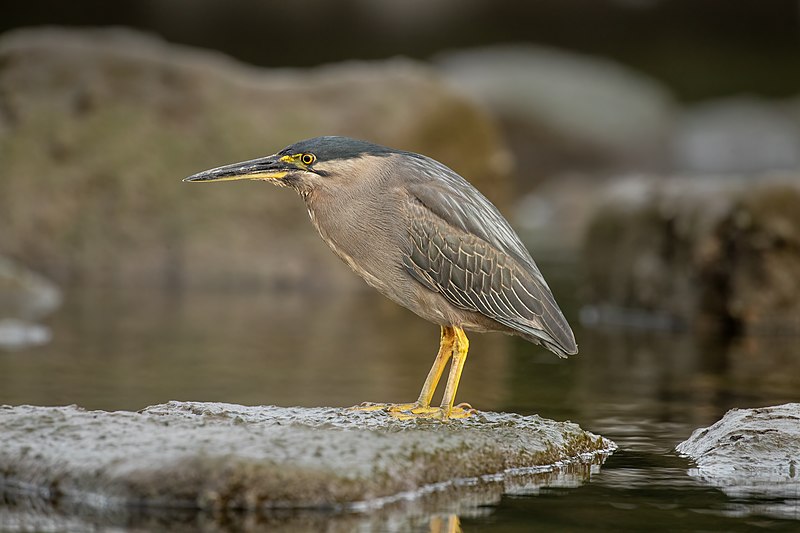
Striated herons are a small species of heron, measuring around 44cm tall. They can be found in wetland areas across the Old World tropics, from west Africa to Japan and Australia as well as South America and the Caribbean.
Striated herons have some interesting behavioral traits that make them unique; they’re mostly sedentary birds who tend to stay close to their breeding habitats throughout most of the year.
During breeding season these little green-backed herons become more active, often performing courtship dances in order to attract mates before nesting together on nearby trees or shrubs.Scientific classification:
| Kingdom | Animalia |
| Phylum | Chordata |
| Class | Aves |
| Order | Pelecaniformes |
| Family | Ardeidae |
| Genus | Butorides |
| Species | B. striata |
31. Little Blue Heron
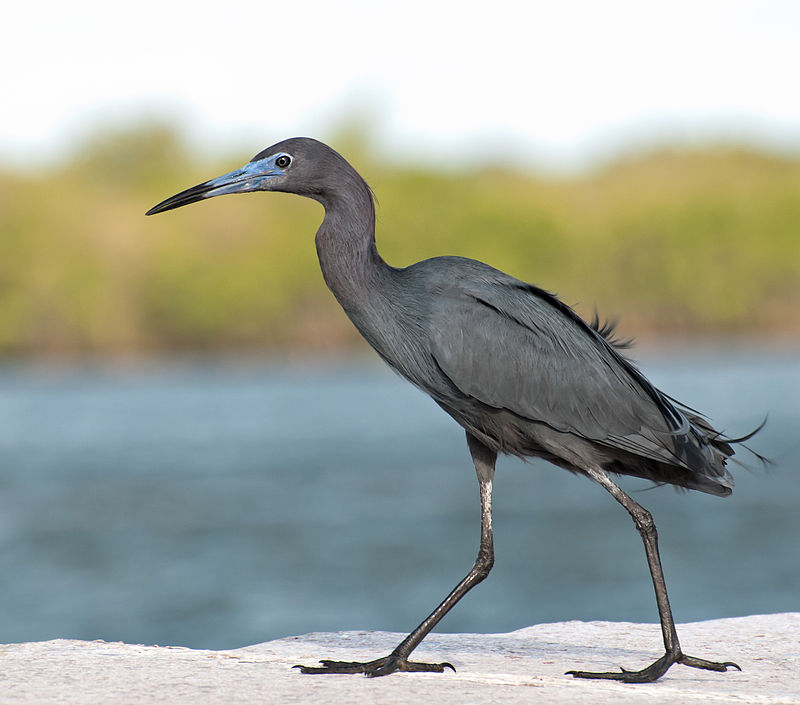
The Little Blue Heron is a small, darkly-colored heron with two-toned bill. Juveniles are completely white, similar to the Snowy Egret. In breeding season, adults develop unique coloration on their head and legs.
The bird has an expansive habitat range that covers much of the Americas from North America all the way down to South America.
They feed mostly in shallow water areas like tidal flats or marshes and eat small aquatic animals such as fish, frogs and crustaceans.
This species can also be found along coastal regions where they gather at night for roosting purposes during winter months when food sources become more scarce due to migration patterns of its prey animals.
These birds have adapted well over time allowing them to persist in most habitats throughout their wide range even despite environmental changes caused by human activities such as pollution or development projects near wetlands ecosystems which are essential for this species’ survival.Scientific classification:
| Kingdom | Animalia |
| Phylum | Chordata |
| Class | Aves |
| Order | Pelecaniformes |
| Family | Ardeidae |
| Genus | Egretta |
| Species | E. caerulea |
32. Tanagers
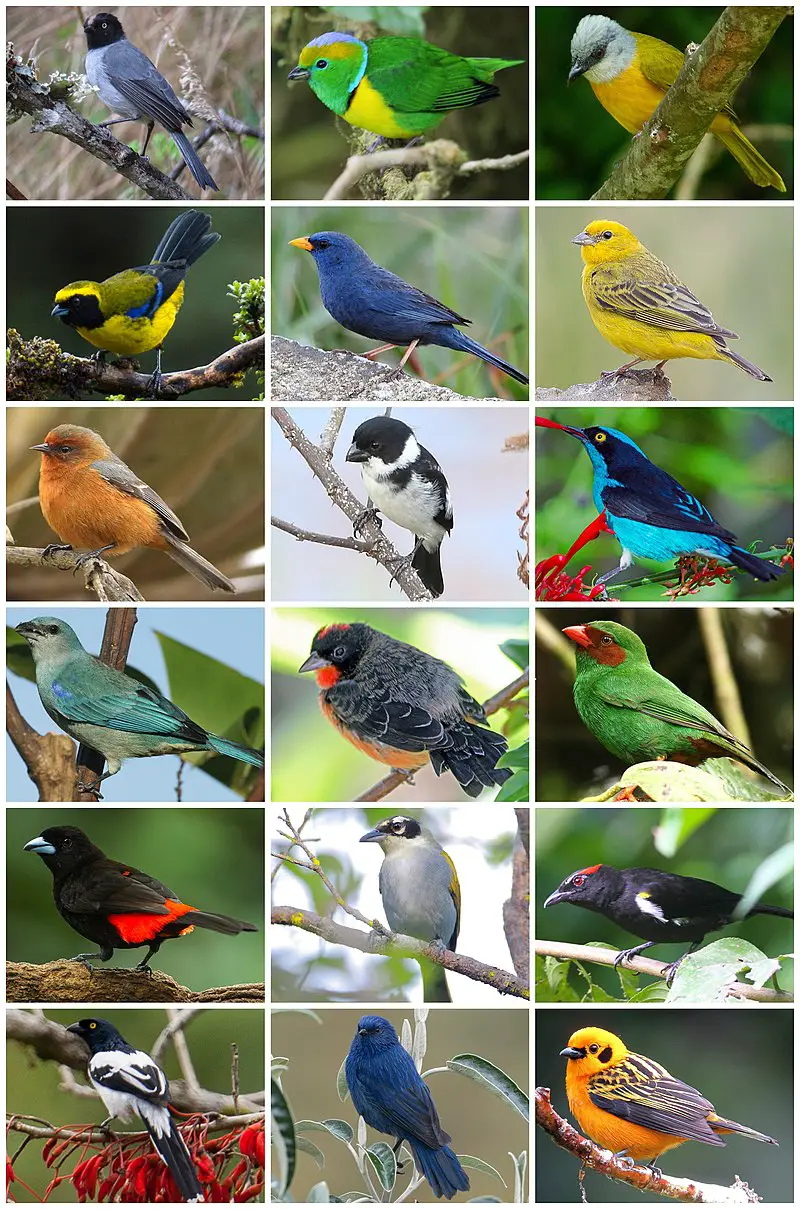
The Tanagers are a beautiful and diverse family of birds native to the Neotropical region. They boast an impressive array of colors, including blues, greens, yellows and reds.
The most common type is the fruit-eating tanager that can be found in tropical forests across Latin America. With nearly 240 species worldwide, they represent almost 4% of all avian species.
These vibrant birds have adapted well to their environment due to their strong bills used for cracking open hard fruits as well as sharp claws for gripping branches while feeding or perching.
As with many other bird families there is natural variation among populations making each one unique in its own way; something that makes them even more special.Scientific classification:
| Kingdom | Animalia |
| Phylum | Chordata |
| Class | Aves |
| Order | Passeriformes |
| Superfamily | Emberizoidea |
| Family | Thraupidae Cabanis, 1847 |
33. Cayenne Jay
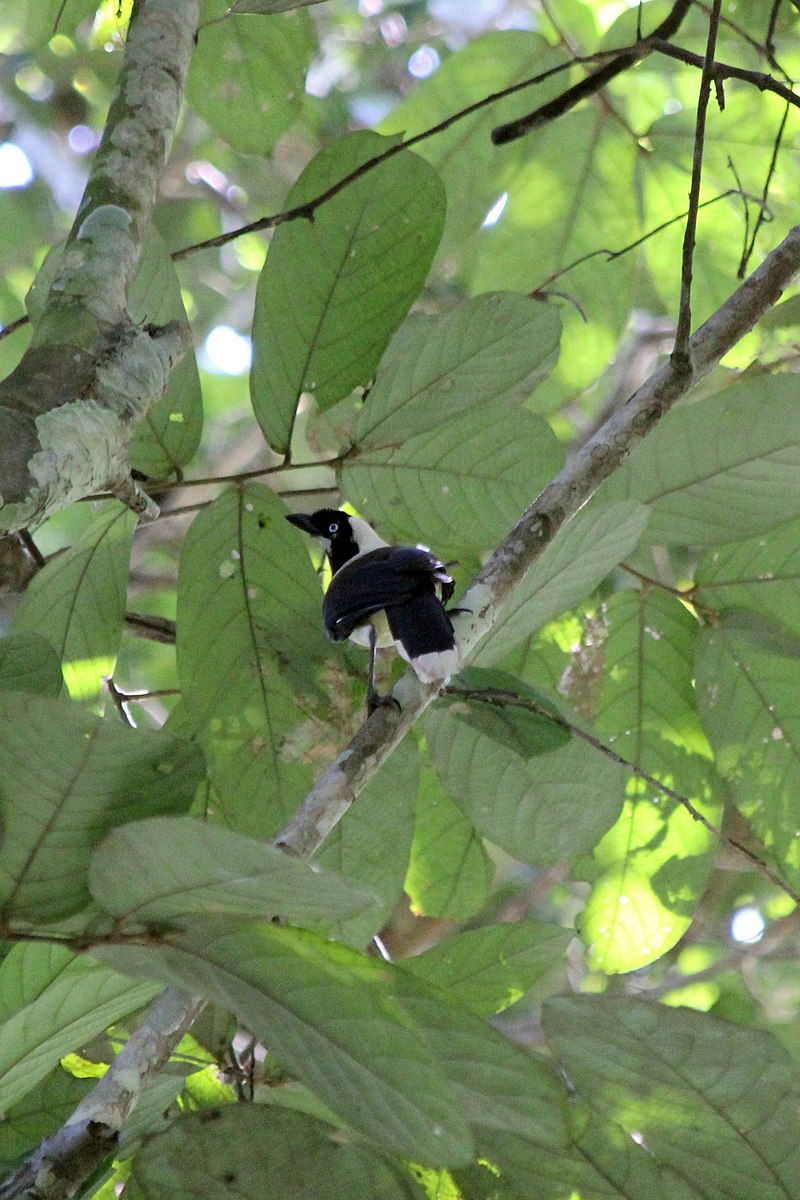
The Cayenne Jay is a species of bird that belongs to the Corvidae family. This small bird can be found in Brazil, French Guiana, Guyana, Suriname and Venezuela.
It prefers to live in subtropical or tropical lowland forests but will also inhabit dry shrublands or heavily degraded former forest areas if necessary.
The first description of this distinctive-looking jay was written by Mathurin Jacques Brisson back 1760.
They have an unmistakable colouration with bright blue feathers on their wings and head contrasted against black bodies which helps them stand out amongst other birds living in their habitat range.
As omnivores they feed mainly on insects as well as fruits and nuts when available; helping disperse seeds throughout the area where they are located too.Scientific classification:
| Kingdom | Animalia |
| Phylum | Chordata |
| Class | Aves |
| Order | Passeriformes |
| Family | Corvidae |
| Genus | Cyanocorax |
| Species | C. cayanus |
34. Yellowish Pipit
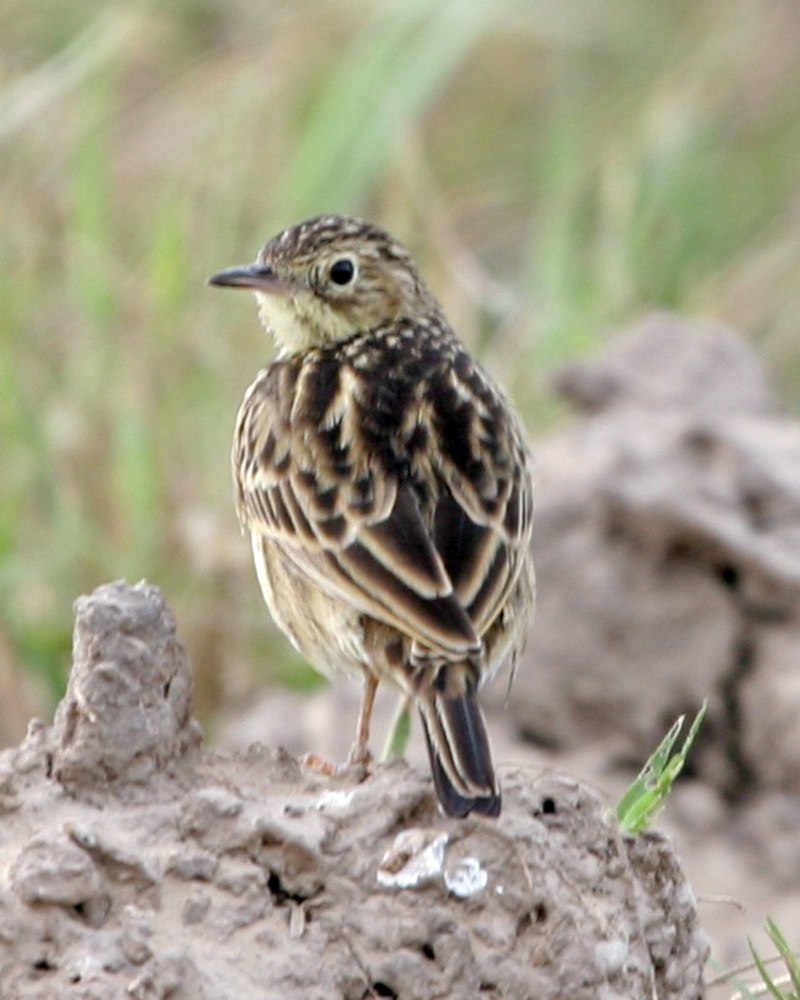
The Yellowish Pipit is a species of bird found in parts of South America. It inhabits temperate grasslands, subtropical wetland and pasture lands.
These birds are medium sized with bright yellow feathers over their bodies and dusky brown wings.
They mainly feed on small insects such as ants, beetles and caterpillars which they find by searching through the ground or low vegetation for food sources.
The Yellowish Pipit sings a variety of songs ranging from simple trills to complex whistles and warbles making it an interesting addition to any avian community.
This species was previously known as Anthus chii until 2022 when its scientific name changed but its common name remains unchanged.Scientific classification:
| Kingdom | Animalia |
| Phylum | Chordata |
| Class | Aves |
| Order | Passeriformes |
| Family | Motacillidae |
| Genus | Anthus |
| Species | A. chii |
35. Common Tody-Flycatcher
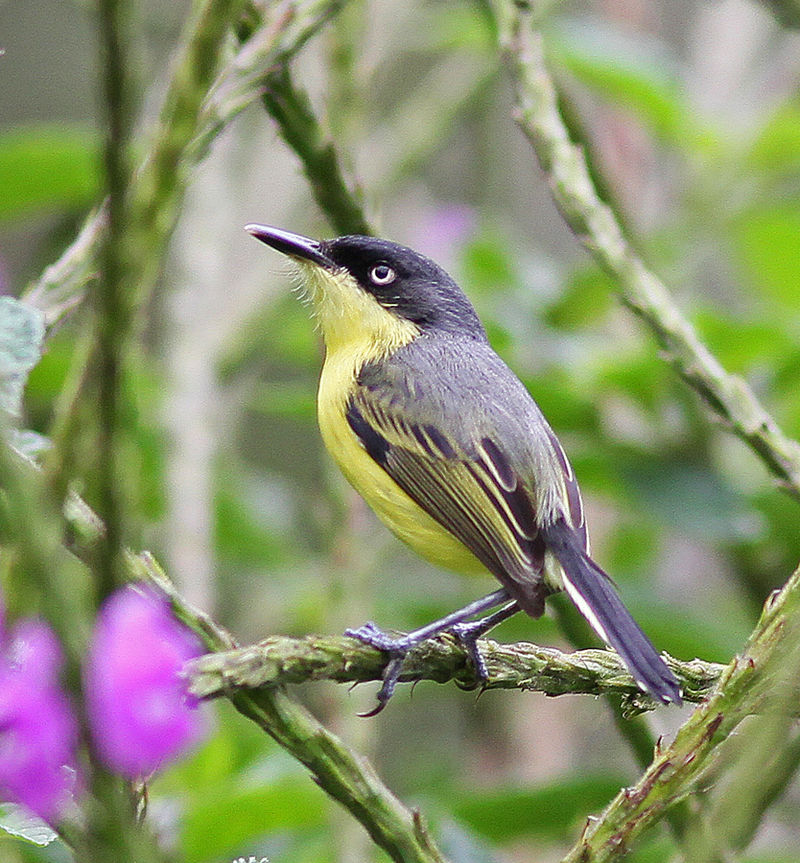
The Common Tody-flycatcher is a vibrant little bird, which belongs to the tyrant flycatcher family.
It inhabits parts of Mexico and South America, ranging from southern Mexico right down to Northwestern Peru, Eastern Bolivia and parts of Brazil.
These birds have beautifully coloured plumage that consists mainly of olive green on their back with white bellies; they also sport black heads with yellow crowns and rufous throats.
They are incredibly small in size – measuring between 10cm – 12 cm long – but make up for it by being highly active during flight as well as vocal.
Their call sounds like “todi” or “tee-dee”. As insectivores these birds feed primarily off insects such as moths, crickets and spiders amongst others found within trees where they usually nest in cavities or crevices close to the tree trunk.Scientific classification:
| Kingdom | Animalia |
| Phylum | Chordata |
| Class | Aves |
| Order | Passeriformes |
| Family | Tyrannidae |
| Genus | Todirostrum |
| Species | T. cinereum |
36. Spotted Sandpiper
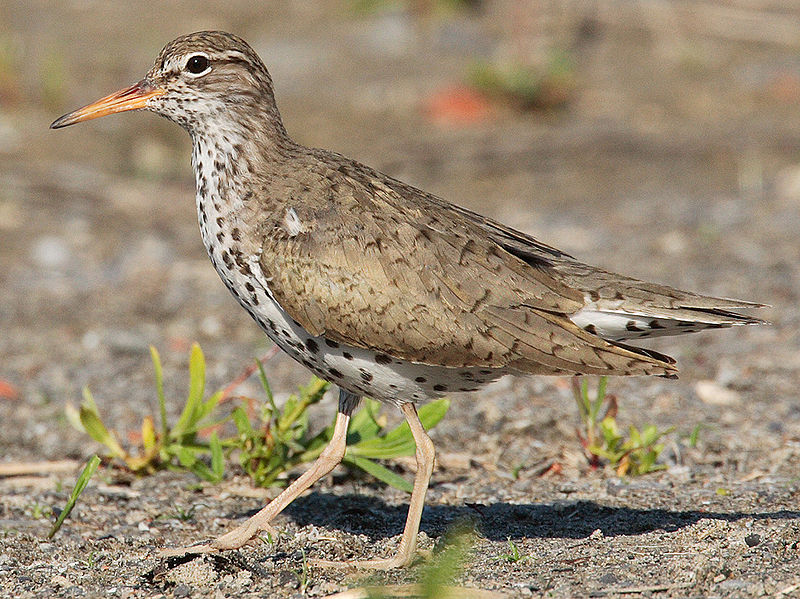
The Spotted sandpiper (Actitis macularius) is a small shorebird that can be found across North America and parts of South America.
It has an appealing spotted plumage, predominately brown in colour with white spots on the wings, tail feathers, head and neck.
The Common Sandpiper (A. hypoleucos) is its sister species which takes over geographically when the other moves away; they have been known to hybridize as well when strays settle down among breeders.
This bird was first described by Carl Linnaeus in 1766 in his twelfth edition of Systema Naturae as a migratory summer visitor to Europe but it now also occupies many habitats too like beaches, riversides and even grasslands during migration periods or for breeding season itself.
Its diet consists mainly of insects such as air-borne flies plus molluscs from shallow water areas – this makes them quite unique amongst waders.Scientific classification:
| Kingdom | Animalia |
| Phylum | Chordata |
| Class | Aves |
| Order | Charadriiformes |
| Family | Scolopacidae |
| Genus | Actitis |
| Species | A. macularius |
Also Featured In: Common Central Park Birds, Birds in Calgary You’ll Love to See
37. Rusty-Margined Flycatcher
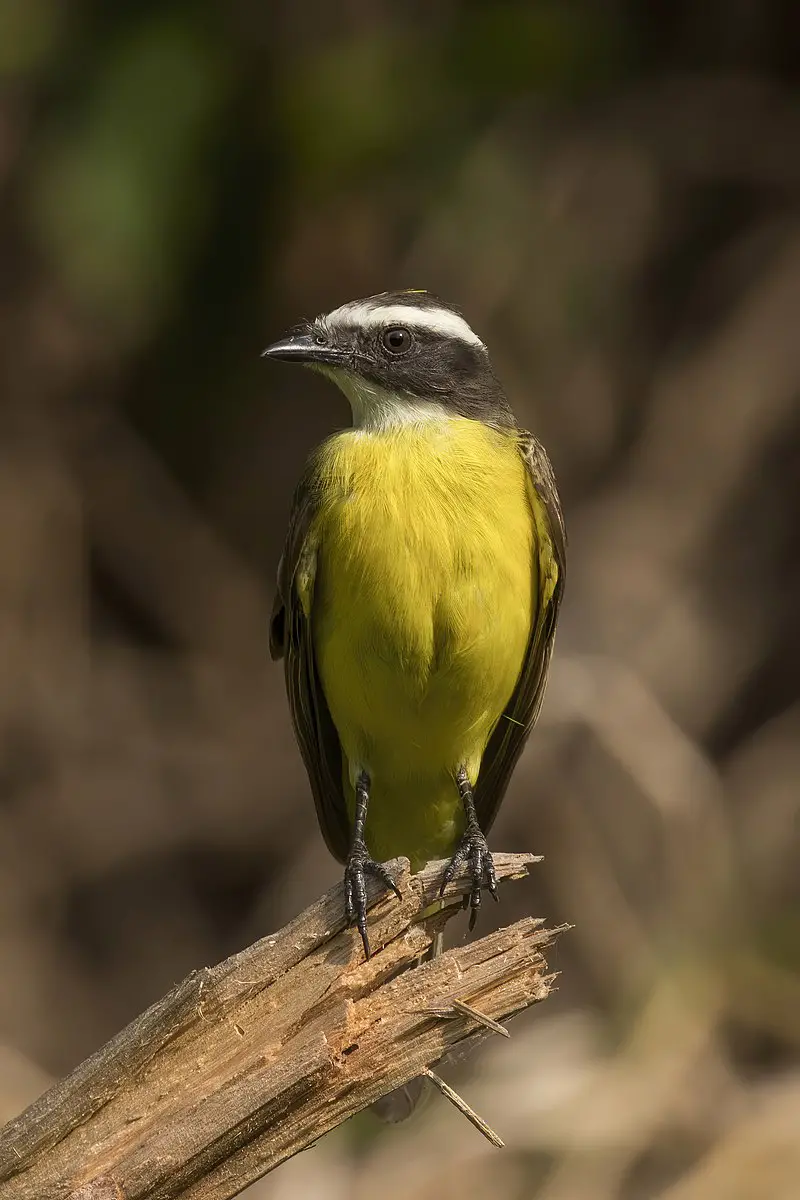
The Rusty-margined Flycatcher is a species of bird found in northern and central South America, from Bolivia to Venezuela. It also resides in eastern Panama.
This small flycatcher prefers subtropical or tropical moist lowland forests as well as heavily degraded former forest for its habitat.
Its diet consists mainly of insects that it catches midair while flying around the canopy layer; however, they will occasionally eat fruit when available too.
The rusty-margined flycatcher has an olive green back with rusty wings and tail feathers; males have black heads while females are brownish grey above their eyes and white below them instead.
This medium sized songbird is considered not threatened by IUCN but populations may be declining due to deforestation activities in some areas where these birds reside.Scientific classification:
| Kingdom | Animalia |
| Phylum | Chordata |
| Class | Aves |
| Order | Passeriformes |
| Family | Tyrannidae |
| Genus | Myiozetetes |
| Species | M. cayanensis |
38. White-Winged Swallow
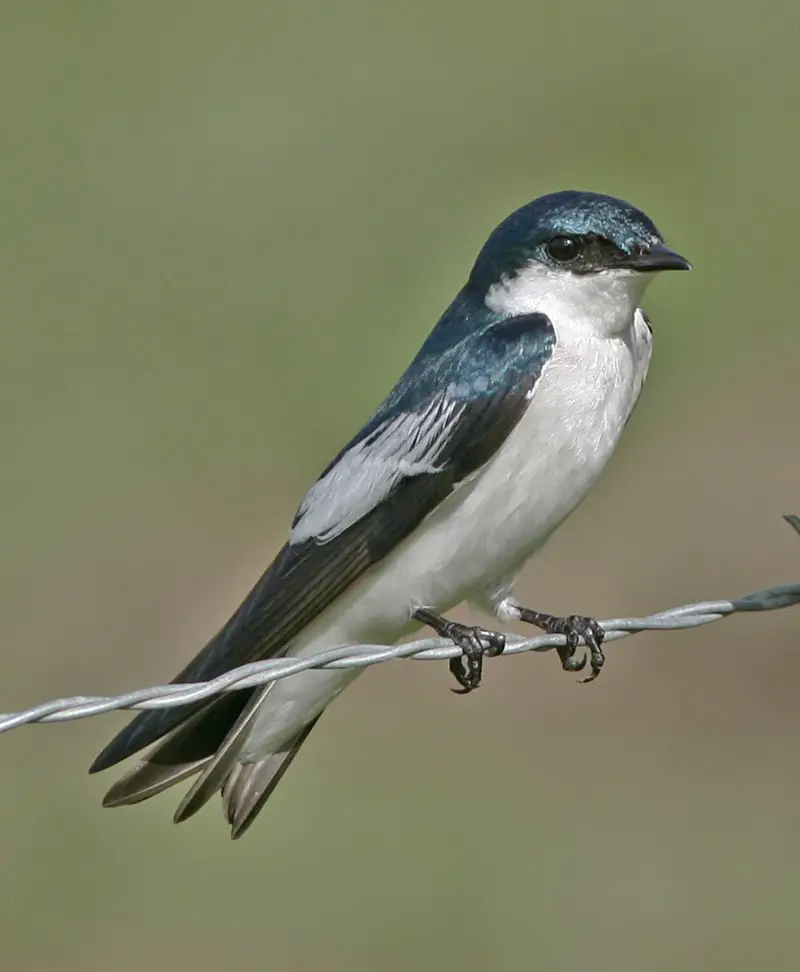
The White-winged Swallow is a small, brown bird with distinctive white patches on its wings and tail feathers. It can be found in tropical South America from Colombia to Argentina, but not west of the Andes.
These birds are mainly non-migratory and live in open habitats such as fields or grasslands.
The species was first described by Georges-Louis Leclerc in 1780 and they feed mostly on insects which they typically catch while flying low over water bodies or vegetation.
They build their nests near cliff faces where there is plenty of protection from predators such as hawks and owls.
With their beautiful plumage, these swallows make for interesting sights when spotted soaring gracefully through the air.Scientific classification:
| Kingdom | Animalia |
| Phylum | Chordata |
| Class | Aves |
| Order | Passeriformes |
| Family | Hirundinidae |
| Genus | Tachycineta |
| Species | T. albiventer |
39. House Wren
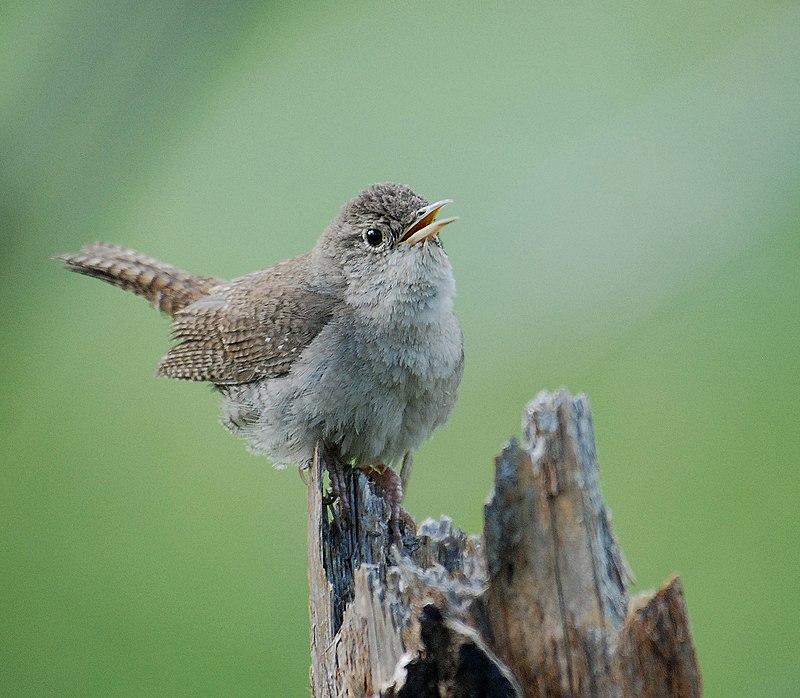
The House Wren is a small bird of the wren family found from Canada to South America. It’s quite common in suburban areas and is one of the most widely distributed native birds in North and South America.
Its taxonomy can be complicated, with some subspecies groups considered separate species.
The House Wren has a brown back, grey head, white eyebrow stripes, light chestnut belly and buffy flanks.
They often inhabit old or abandoned buildings as well as shrublands near fields or open woods for nesting sites.
During breeding season they are highly territorial so make sure you create an inviting environment if you wish to invite them into your yard.Scientific classification:
| Kingdom | Animalia |
| Phylum | Chordata |
| Class | Aves |
| Order | Passeriformes |
| Family | Troglodytidae |
| Genus | Troglodytes |
| Species | T. aedon |
Also Featured In: Birds That Live in Colorado, Birds Commonly Found in New York
40. Greater Yellow-Headed Vulture
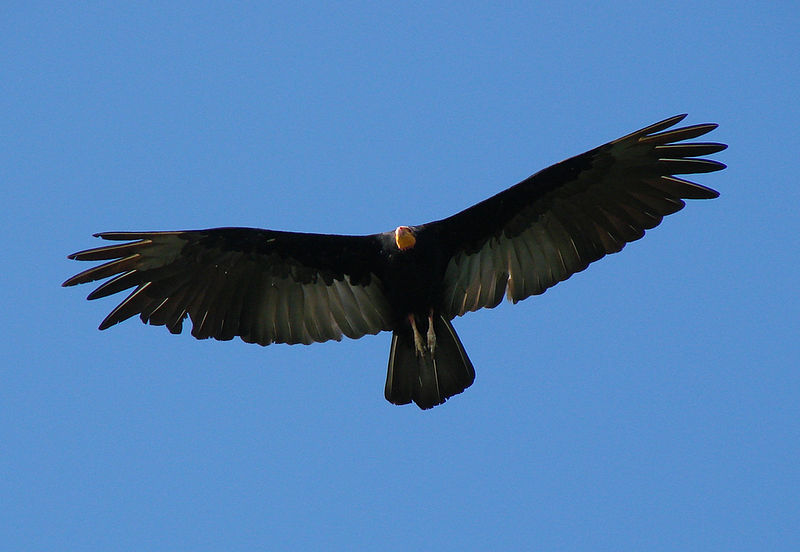
The Greater yellow-headed vulture is a species of bird belonging to the New World Vulture family. It has a wingspan ranging from 166-178 cm and can be found in tropical moist lowland forests located in South America.
This bird is an excellent scavenger, as it mainly feeds on carrion and sometimes eggs or nestlings of other birds.
They are also known for their loud calls that act as signals between different individuals within the same group.
The population size of the greater yellow-headed vulture remains stable globally, however there are certain areas where its numbers have decreased due to threats such deforestation and hunting by humans.
Conservation efforts should thus focus on preserving suitable habitats so these majestic birds can continue to thrive.Scientific classification:
| Kingdom | Animalia |
| Phylum | Chordata |
| Class | Aves |
| Order | Accipitriformes |
| Family | Cathartidae |
| Genus | Cathartes |
| Species | C. melambrotus |
Also Featured In: Rainforest Birds You Should Know,
41. Spotted Tody-Flycatcher
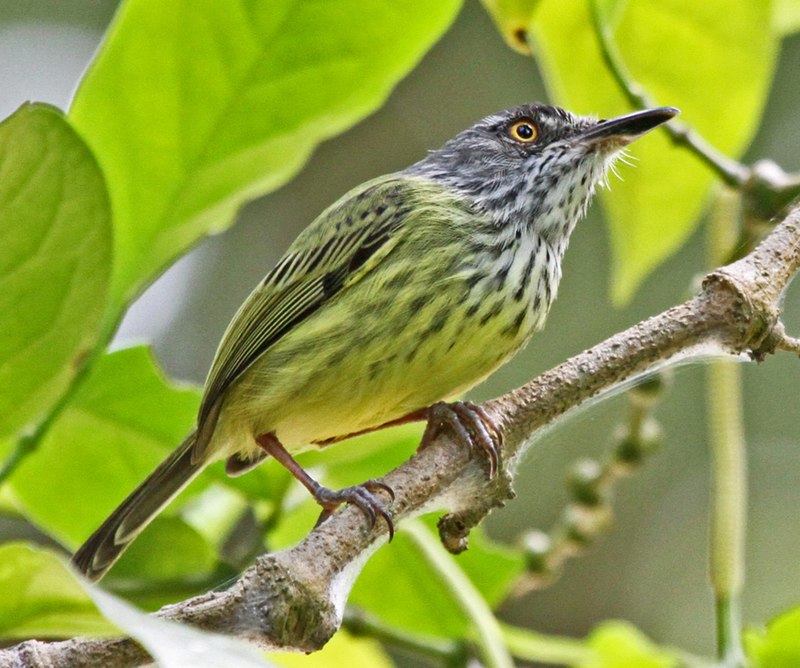
The spotted tody-flycatcher is a species of bird found in many countries across South America, including Bolivia, Brazil, Colombia and Guyana.
It inhabits subtropical or tropical moist lowland forests where it feeds on insects by perching atop branches and catching them with its slender bill.
Its plumage ranges from olive green above to yellowish white undersides; the wings are heavily marked with black spots while the tail has two narrow bars at the base.
The most distinguishing feature is a bright orange-red forehead patch which can be seen even when they’re perched high up in trees.
This small songbird may not be as showy as other birds but their call – an easily recognizable loud bubbling “peep peep”– will always make you pause for just one more listen.Scientific classification:
| Kingdom | Animalia |
| Phylum | Chordata |
| Class | Aves |
| Order | Passeriformes |
| Family | Tyrannidae |
| Genus | Todirostrum |
| Species | T. maculatum |
42. Wing-Barred Seedeater
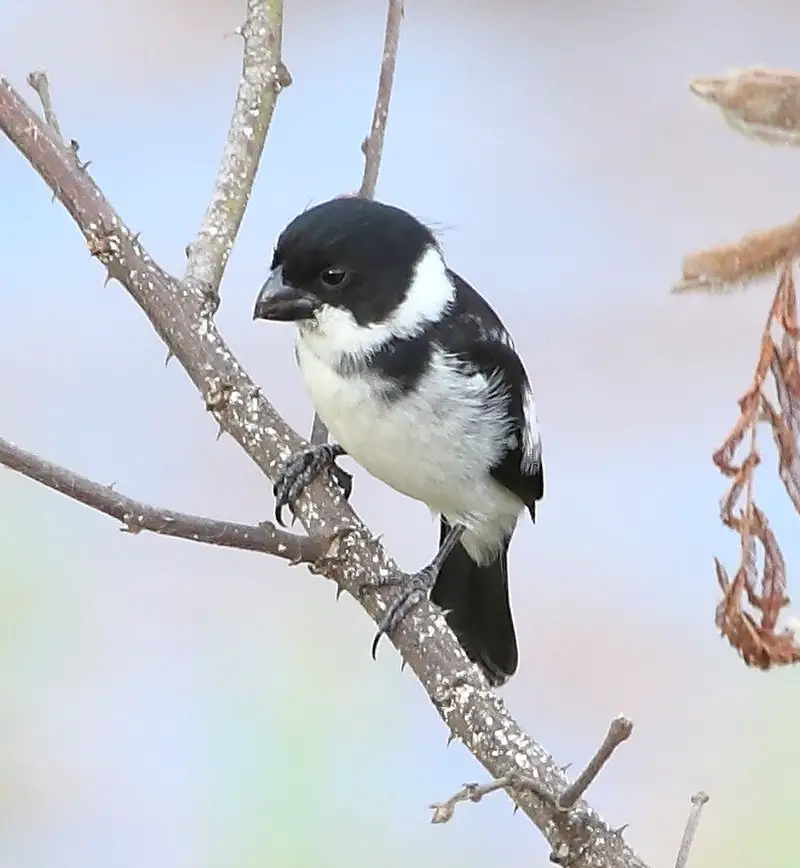
The Wing-barred Seedeater is a passerine bird found in coastal regions of north-eastern South America and along the Amazon River.
It has distinctive wing bars, giving it its name, and features greyish/yellowish plumage with darker wings and tail.
The bill is long and pointed while the legs are pink or yellowish. They feed mainly on seeds taken from grasses but also occasionally take insects when available.
During the breeding season they become more vocal making short twittering calls to attract mates for nesting purposes in dense vegetation close to water sources such as rivers or swamps.
Its population numbers have been declining due to habitat loss caused by deforestation but conservation efforts are helping some areas recover their populations of this beautiful speciesScientific classification:
| Kingdom | Animalia |
| Phylum | Chordata |
| Class | Aves |
| Order | Passeriformes |
| Family | Thraupidae |
| Genus | Sporophila |
| Species | S. americana |
43. Blue-Black Grassquit
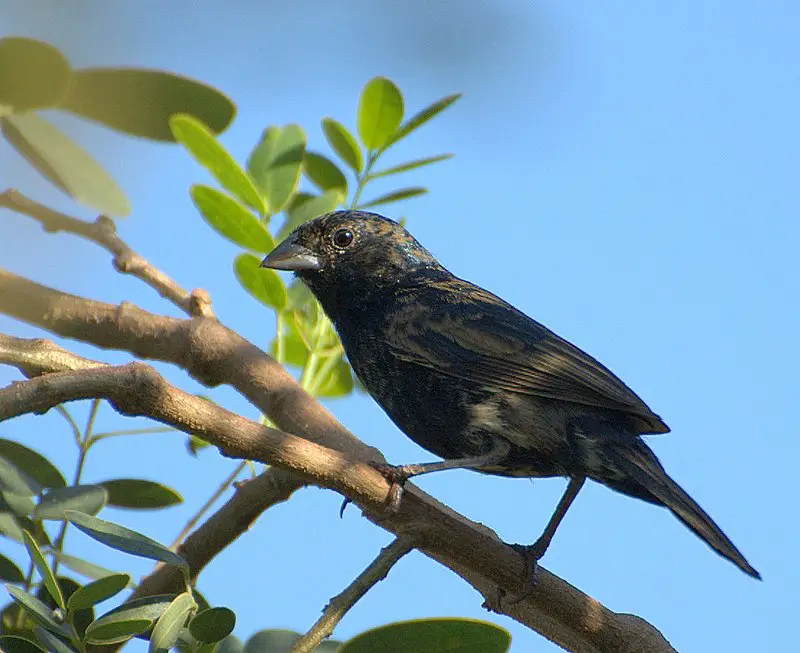
The Blue-black Grassquit is a small and vibrant bird belonging to the tanager family, Thraupidae.
It has an extremely wide range of distribution stretching from southern Mexico all the way through Central America and South America as far south as northern Chile, Argentina and Paraguay.
The male of this species features glossy blue-black feathers with yellowish primaries whereas females are less brightly coloured having predominantly greyish brown plumage.
They feed on insects such as ants, grasshoppers and beetles along with some grains they find in their habitats which include open woodlands near water sources or marshes.
These birds build nests made out of leaves lined with soft material like hair or wool at low level vegetation often close to water bodies where they can raise clutches up to two times during breeding seasons depending upon weather conditions around them.Scientific classification:
| Kingdom | Animalia |
| Phylum | Chordata |
| Class | Aves |
| Order | Passeriformes |
| Family | Thraupidae |
| Genus | Volatinia Reichenbach, 1850 |
| Species | V. jacarina |
44. Grey-Breasted Martin
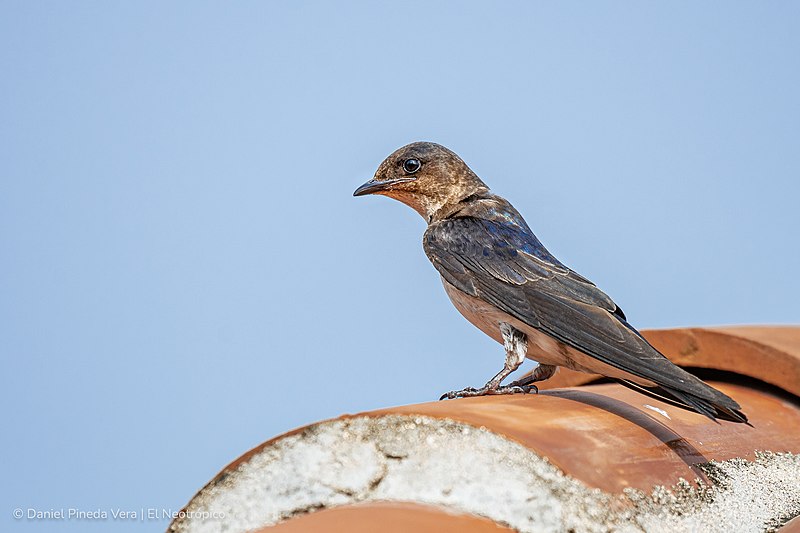
The grey-breasted martin is a large swallow species, native to Central and South America. It has several subspecies, with some migrating north as far as Venezuela during the southern hemisphere’s winter season.
Adults of this species are 18cm long and have forked tails. They mainly feed on insects in open habitats such as savannas or grasslands, but can also be seen near human settlements or agricultural areas.
The birds usually build their nests under bridges or other man-made structures like eaves of buildings or porches where they stay safe from predators.
Grey-breasted martins form monogamous pairs that remain together throughout the year; both male and female take part in nest building activities along with feeding young ones once hatched out of eggs laid by females alone typically laying three to four white eggs per clutch..Scientific classification:
| Kingdom | Animalia |
| Phylum | Chordata |
| Class | Aves |
| Order | Passeriformes |
| Family | Hirundinidae |
| Genus | Progne |
| Species | P. chalybea |
45. Yellow-Headed Caracara
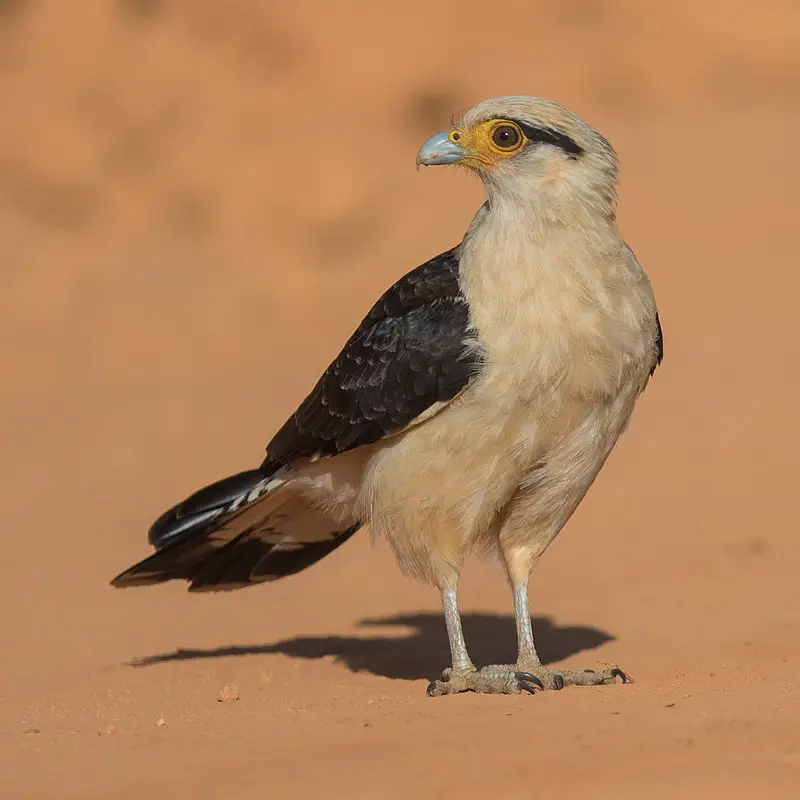
The Yellow-headed Caracara is a majestic bird of prey belonging to the Falconidae family, found in tropical and subtropical South America and southern parts of Central America.
It has an unmistakable bright yellow head that sets it apart from other birds. Unlike its cousins who specialize in fast aerial hunting, the caracara feeds on scavenged food such as dead animals or eggs instead.
Louis Jean Pierre Vieillot first described this species when he discovered them back in 1817. The size varies between 33 cm – 45 cm with wingspan ranging up to 90 cm long.
These stunning birds have a unique red face mask along with black & white plumage across their body which makes them very distinctive looking creatures indeed.Scientific classification:
| Kingdom | Animalia |
| Phylum | Chordata |
| Class | Aves |
| Order | Falconiformes |
| Family | Falconidae |
| Genus | Milvago |
| Species | M. chimachima |
46. Barred Antshrike
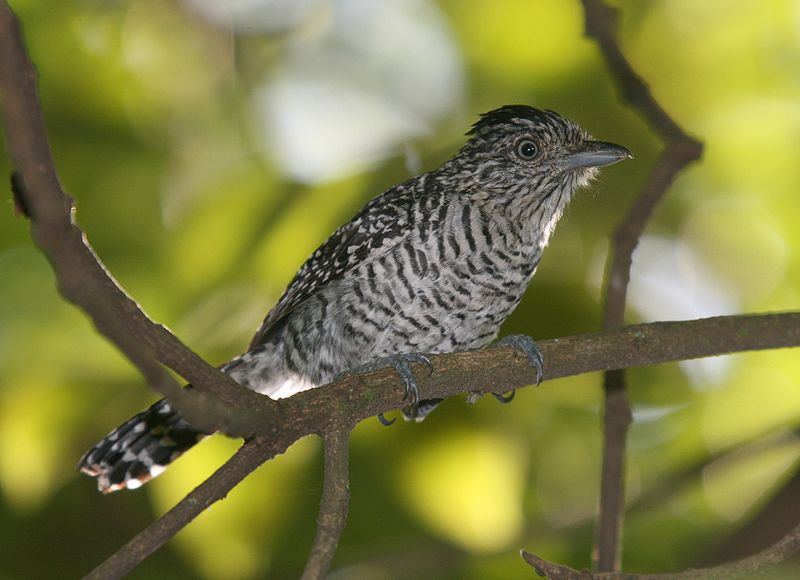
The Barred Antshrike is a beautiful bird belonging to the antbird family. It has an amazing range, being found in Mexico, Central America, Trinidad and Tobago as well as most of South America east of the Andes.
Even southern Texas has one accepted record. This small passerine can be spotted inhabiting wooded habitats that may consist of both dry and humid forests or even plantations with trees.
Its plumage consists mainly of black barring on its chestnut back along with white stripes on its wings giving it a unique look in flight.
Despite their shy nature they are quite vocal during breeding season when males sing from high perches for courtship displays; this is also when you’re likely to spot them at best.Scientific classification:
| Kingdom | Animalia |
| Phylum | Chordata |
| Class | Aves |
| Order | Passeriformes |
| Family | Thamnophilidae |
| Genus | Thamnophilus |
| Species | T. doliatus |
47. Yellow-Chinned Spinetail
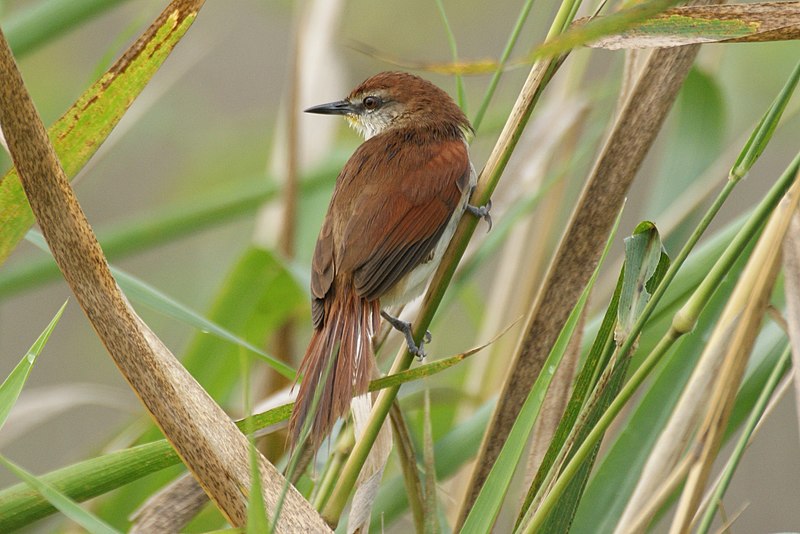
The Yellow-chinned Spinetail is a small bird found in the tropical New World from Trinidad and Colombia down to Argentina and Uruguay.
It has an elongated body, with chestnut brown upperparts and head, while its underparts are white or pale yellow.
Its distinguishing feature is the bright yellow patch on its chin which gives it its name. The wings are long with pointed tips that enable them to maneuver through thick vegetation when searching for food like insects, spiders, fruits and seeds.
This species can be seen alone or in pairs as they make their way around forests edges looking for food or shelter within dense foliage of trees where they build their cup shaped nests made out of grasses twigs lined up with feathers inside.
They have high pitched calls often heard during dawn chorus but will remain hidden until disturbed making it difficult to observe this unique species closely due to its shy nature.Scientific classification:
| Kingdom | Animalia |
| Phylum | Chordata |
| Class | Aves |
| Order | Passeriformes |
| Family | Furnariidae |
| Genus | Certhiaxis |
| Species | C. cinnamomeus |
48. Yellow-Rumped Cacique
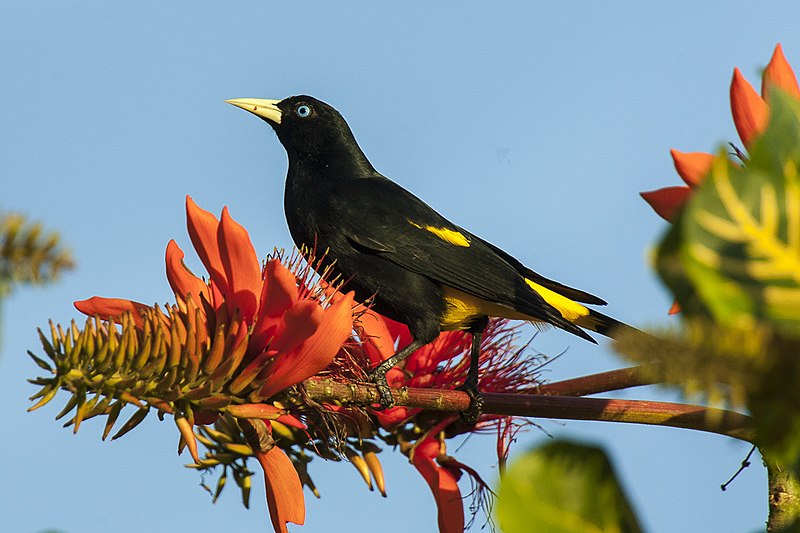
The Yellow-rumped Cacique is a passerine bird belonging to the New World family Icteridae. It can be found in northern South America from Panama and Trinidad southwards until Peru, Bolivia and central Brazil.
They have also been spotted as far north as Nayarit state in Mexico. Its plumage features a black body with yellow rump, white spots on its wings and tail feathers tipped with orange bands – hence its name.
The bird was first formally described by Swedish naturalist Carl Linnaeus back in 1758.
These birds are omnivorous feeders that mainly feast upon fruits like figs or berries but occasionally hunt for insects too.
Their loud calls usually consist of three distinct notes which make them quite easy to identify when heard nearby.Scientific classification:
| Kingdom | Animalia |
| Phylum | Chordata |
| Class | Aves |
| Order | Passeriformes |
| Family | Icteridae |
| Genus | Cacicus |
| Species | C. cela |
49. Tropical Gnatcatcher
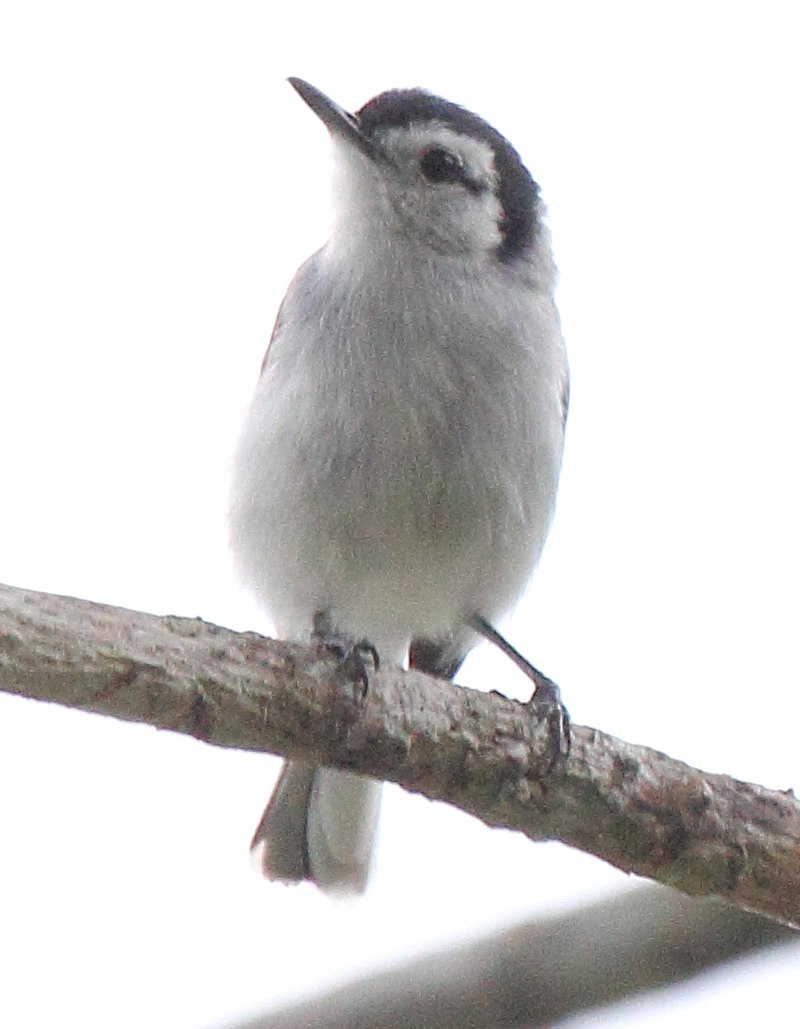
The Tropical Gnatcatcher is a small and active insectivorous songbird found across much of the Neotropics.
It has distinct geographical variations in both its voice and plumage, which have led to some populations being recognised as separate species such as the White-browed Gnatcatcher or Marañón Gnatcatcher.
This bird typically feeds on flying insects, gathering them from leaves with short flights before returning back to its perch.
Its wings are usually greyish brown while its tail is black with white outer feathers that it uses for display during courtship rituals.
The tropical gnatcatcher also plays an important role within their local ecosystems by controlling pest populations through predation and providing food sources for other animals like bats and reptiles.Scientific classification:
| Kingdom | Animalia |
| Phylum | Chordata |
| Class | Aves |
| Order | Passeriformes |
| Family | Polioptilidae |
| Genus | Polioptila |
| Species | P. plumbea |
50. Green-Backed Trogon
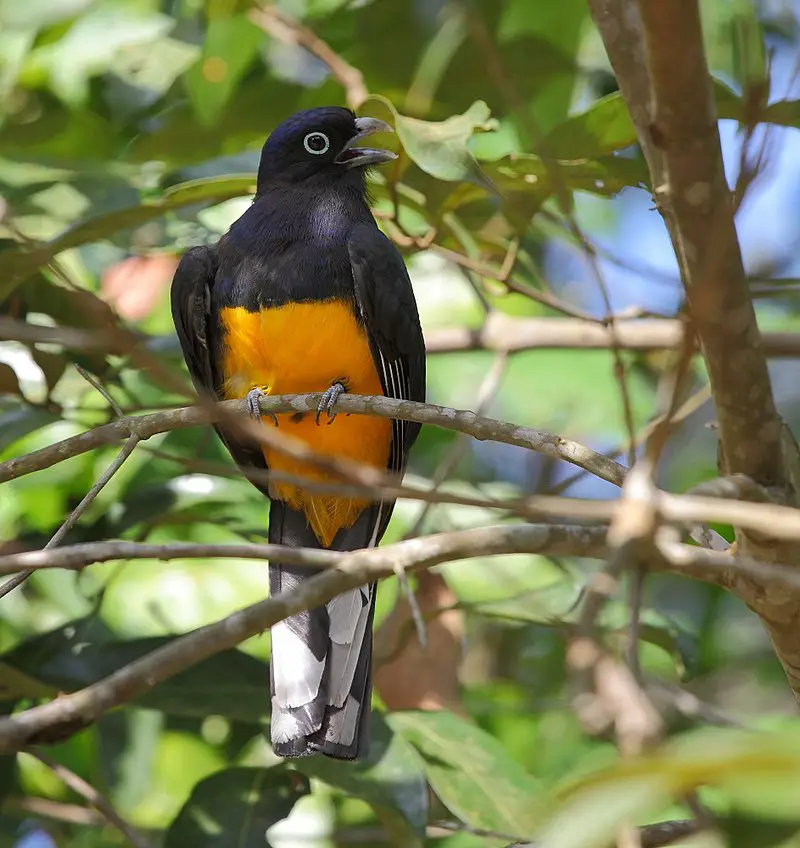
The Green-backed Trogon is a beautiful bird found in the Amazon rainforest and southeast coast of Brazil. It belongs to the trogon family, which are known for their distinct coloration.
The male has bright green upperparts with blue head that transitions into pale yellow on its belly, lacking a white breastband.
Females have brownish upperparts and olive underparts with barring throughout both sexes.
They usually feed on insects such as beetles or grasshoppers while hovering in midair before swooping down to catch prey.
This species can also be seen perched atop tree branches looking out for potential meals. Its vibrant colors make it one of most stunning birds around and an absolute must-see when visiting its natural habitat.Scientific classification:
| Kingdom | Animalia |
| Phylum | Chordata |
| Class | Aves |
| Order | Trogoniformes |
| Family | Trogonidae |
| Genus | Trogon |
| Species | T. viridis |
51. Psophia
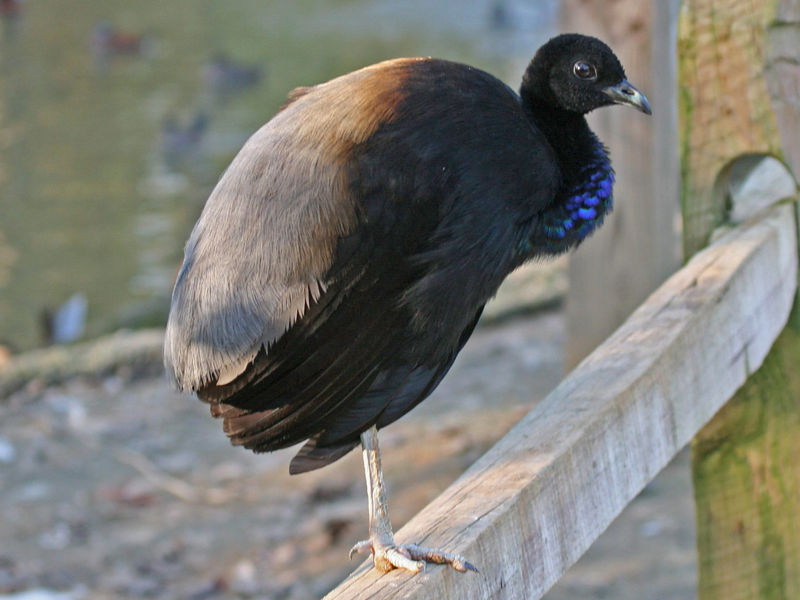
Psophia is a genus of birds found in South America, and are the only members of the Psophiidae family. They have an unmistakable appearance, with their long legs and necks giving them a chicken-like stature.
Males make loud trumpeting or cackling noises when they feel threatened. The three species range from 45 to 52 centimetres (18 to 20 inches) in length, weighing up to 1.5 kg (2 lbs).
They live mainly in humid forests across the Amazon and Guiana Shield regions, where there is plenty for them forage on such as fruit, insects and small animals like lizards or frogs.
These fascinating creatures play an important role within their environment; helping disperse seeds throughout the forest by eating fruits which contain large quantities of seeds that will eventually be spread elsewhere through defecation.Scientific classification:
| Kingdom | Animalia |
| Phylum | Chordata |
| Class | Aves |
| Order | Gruiformes |
| Family | Psophiidae Bonaparte, 1831 |
| Genus | Psophia Linnaeus, 1758 |